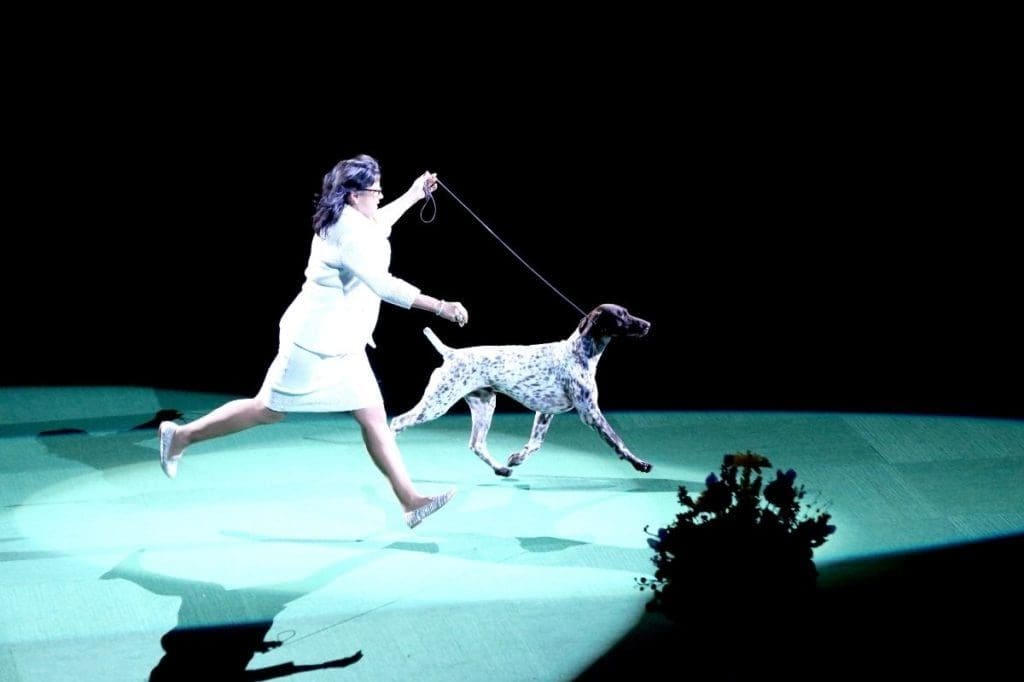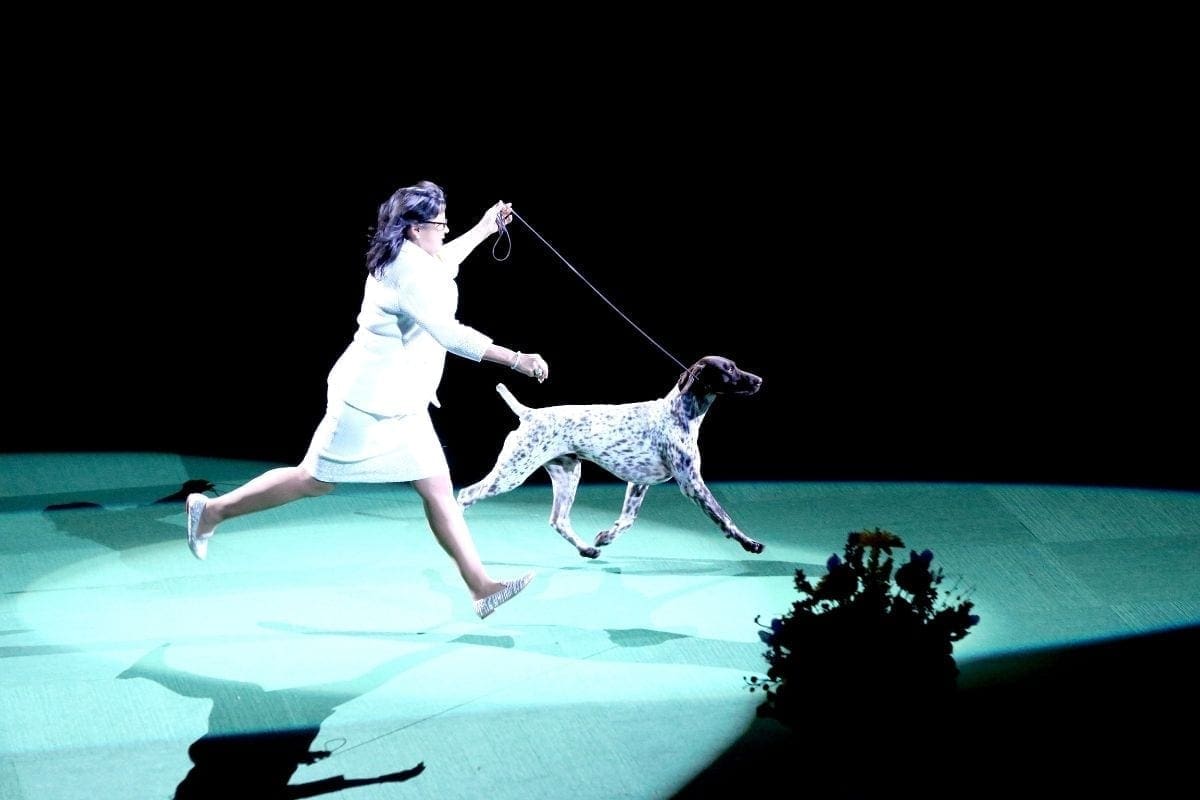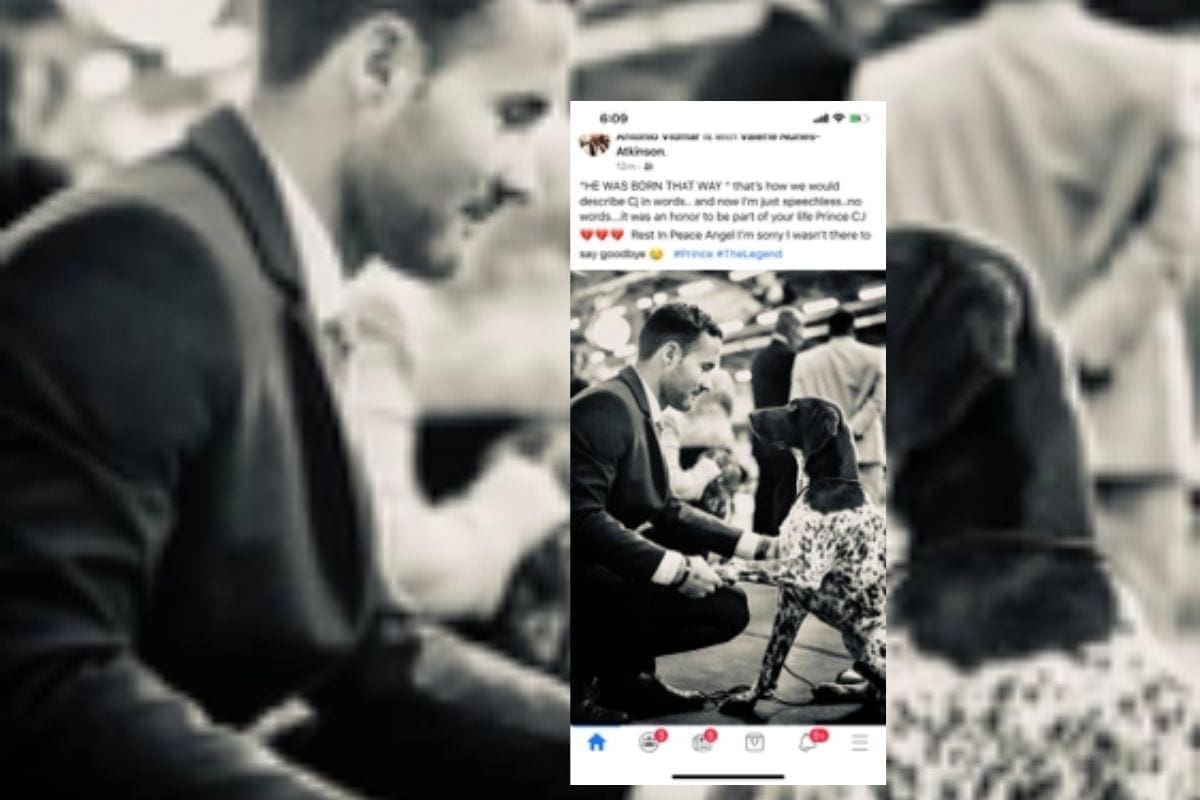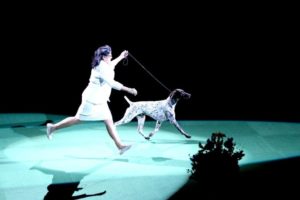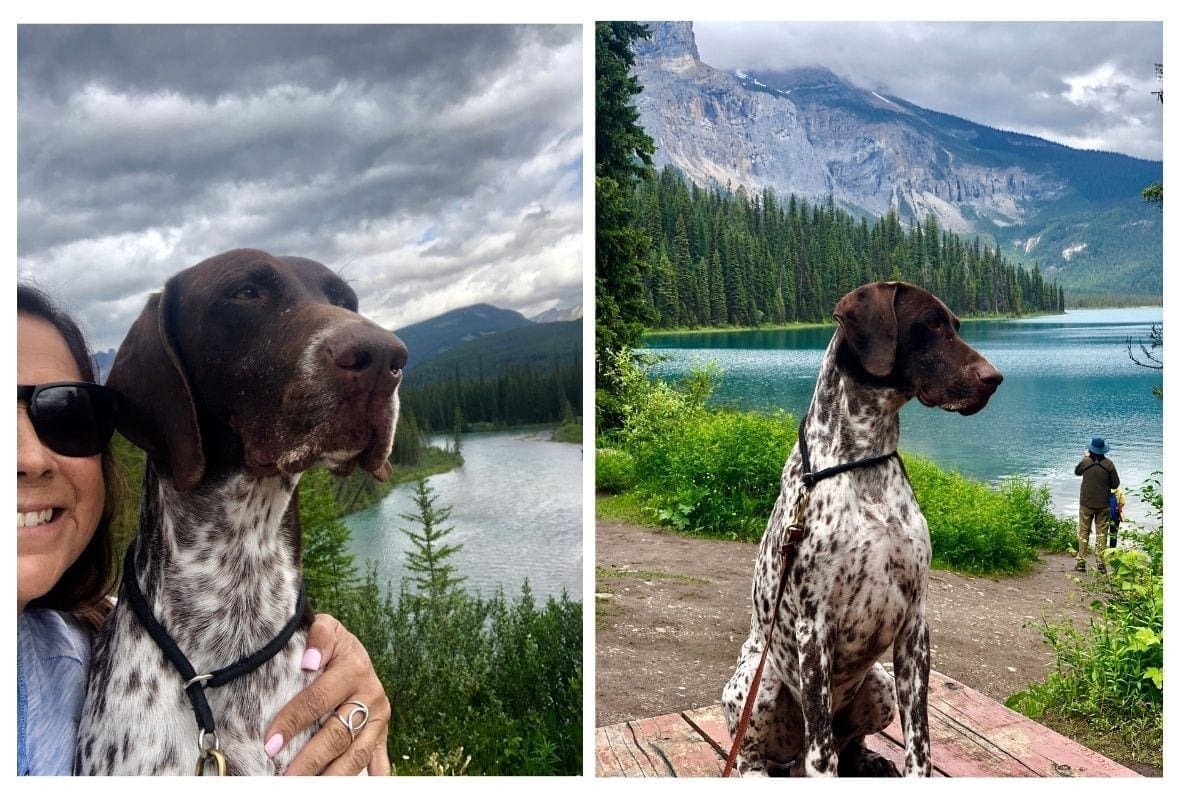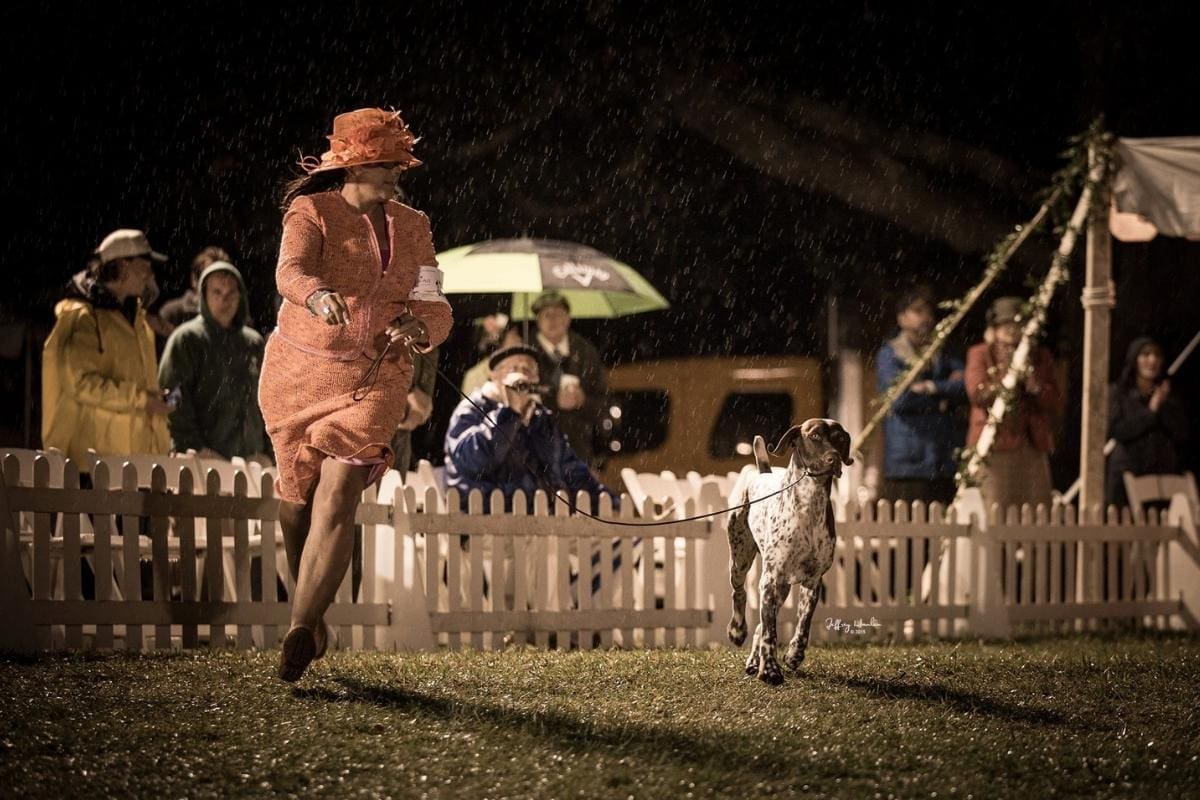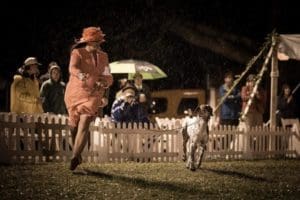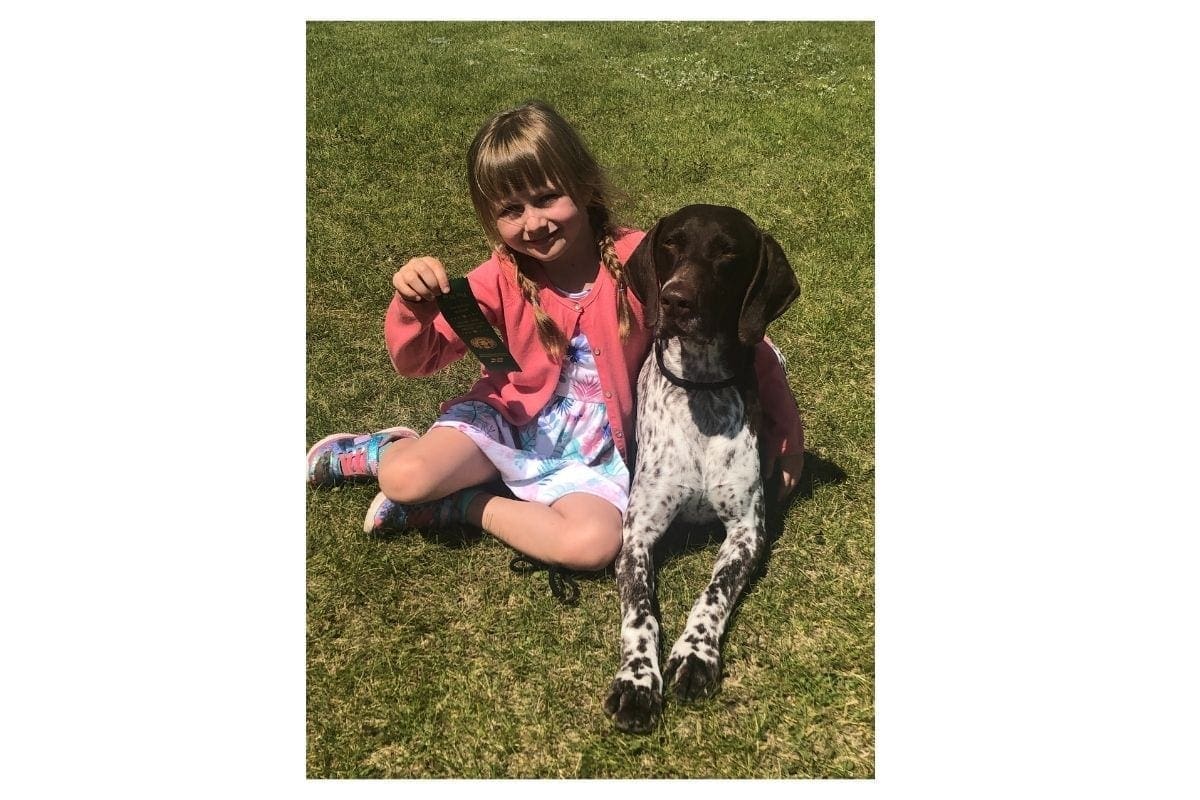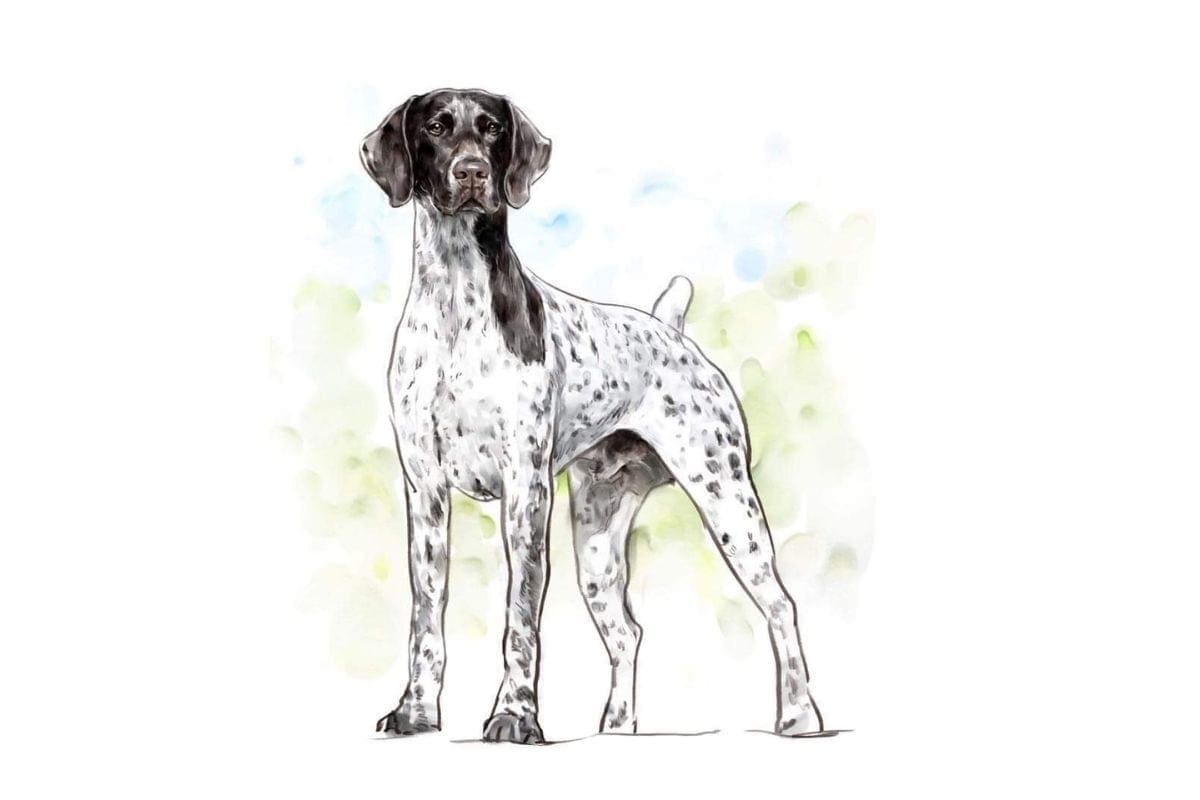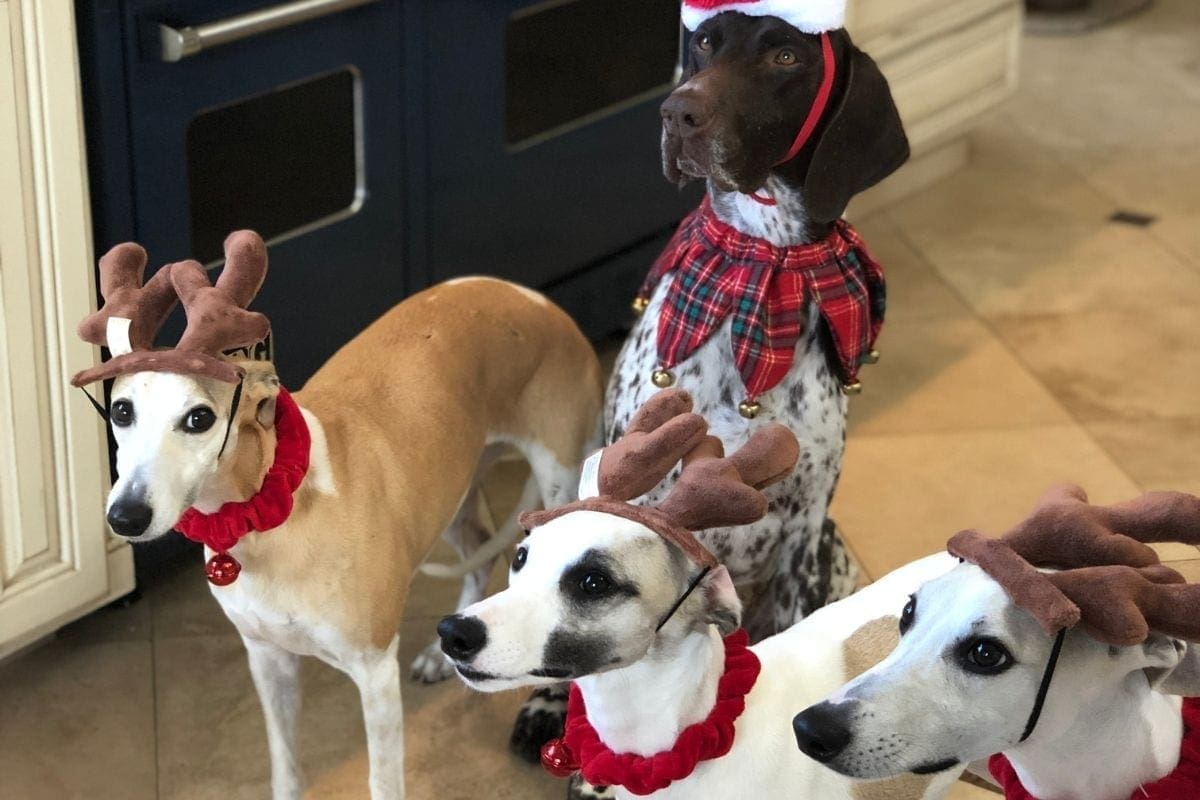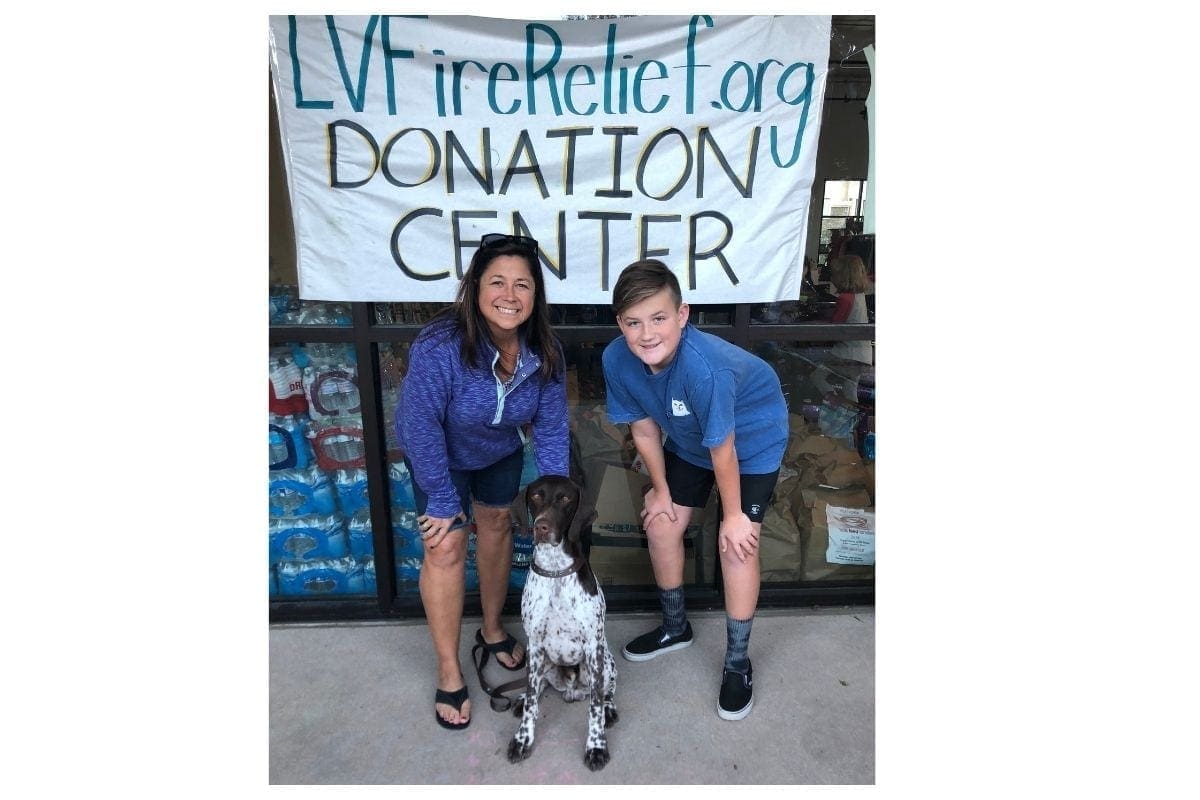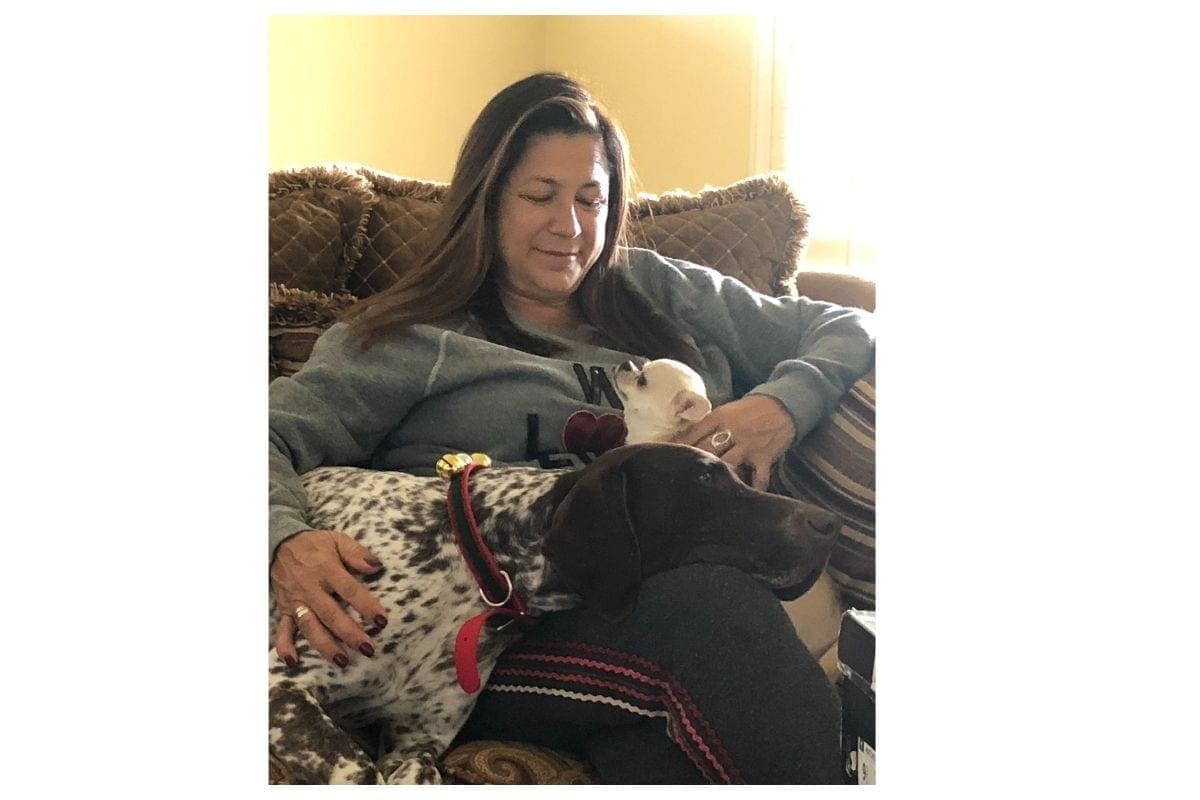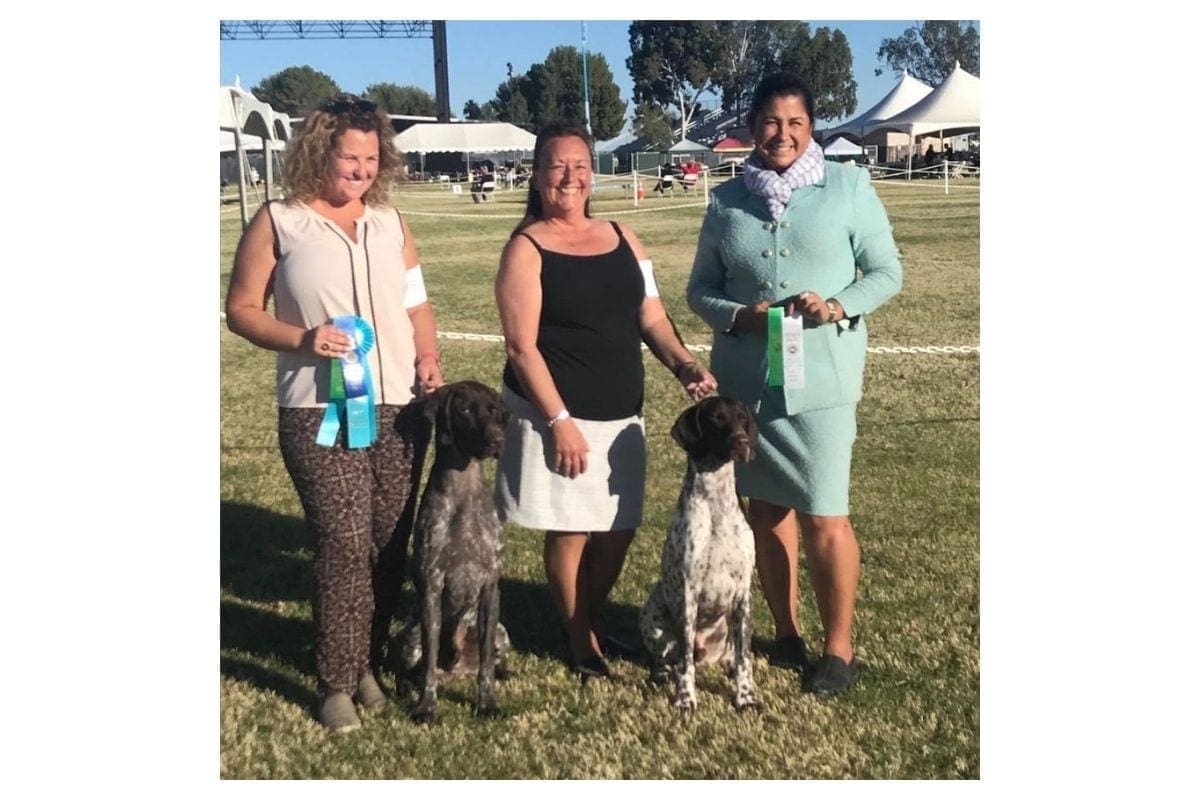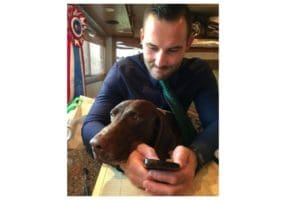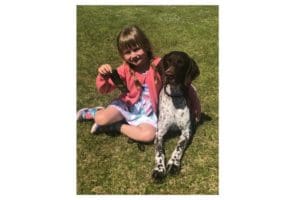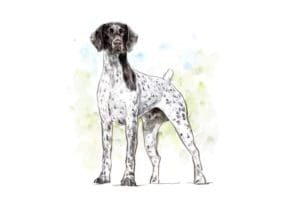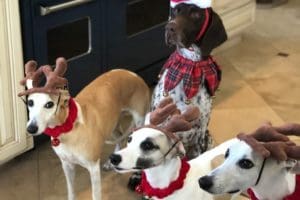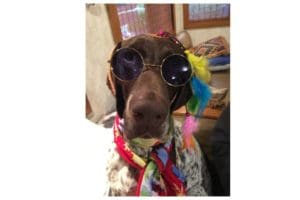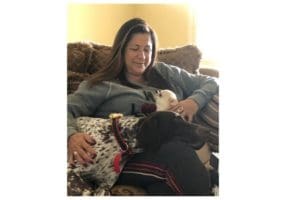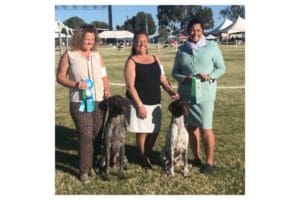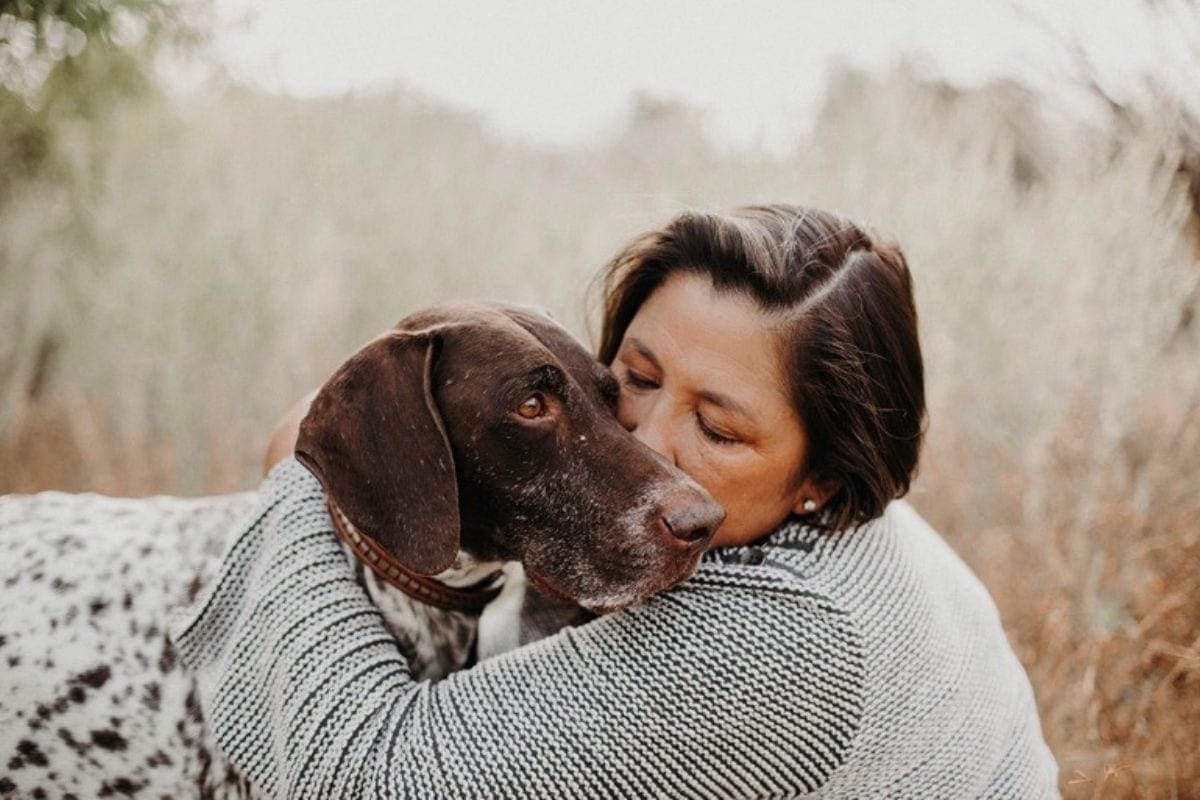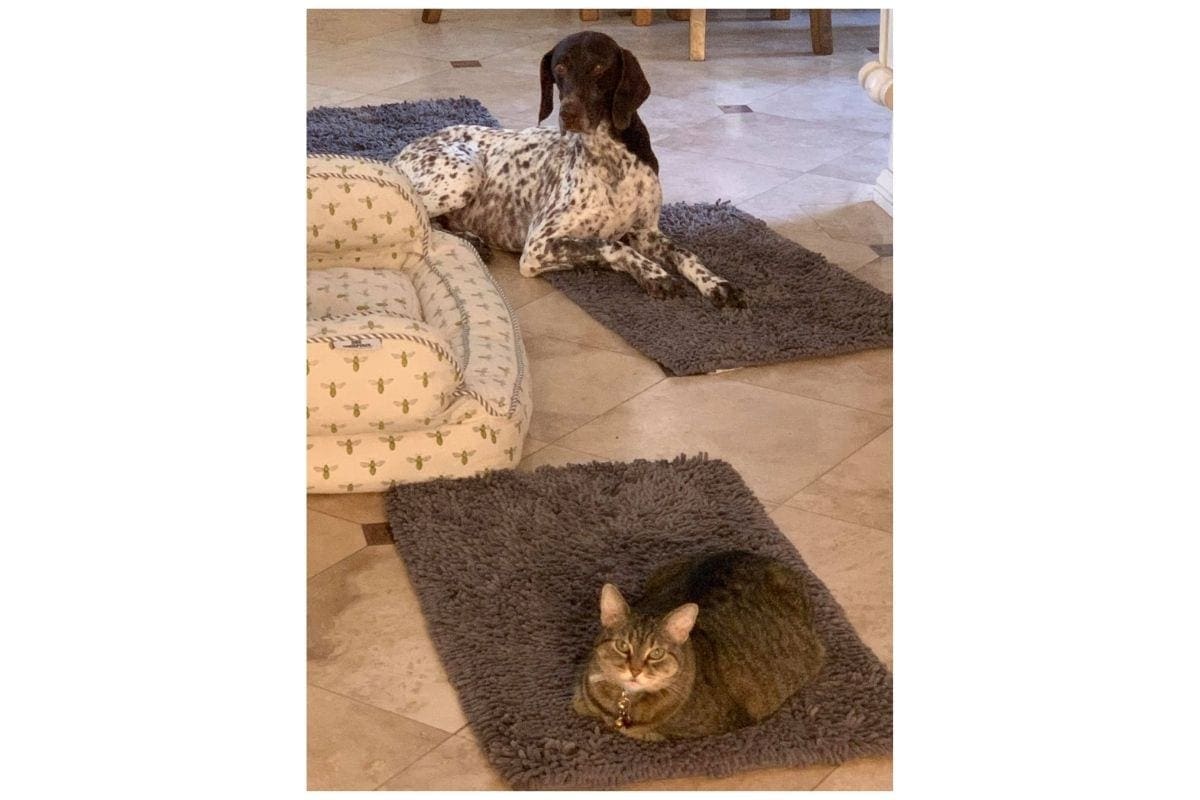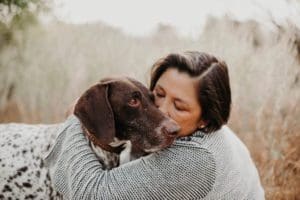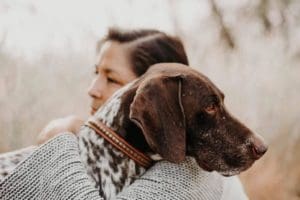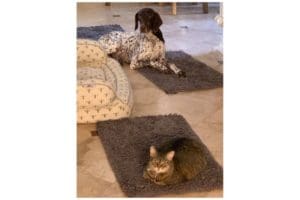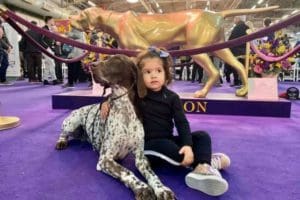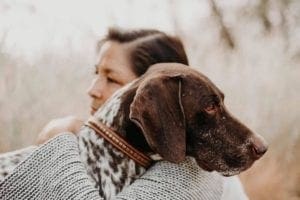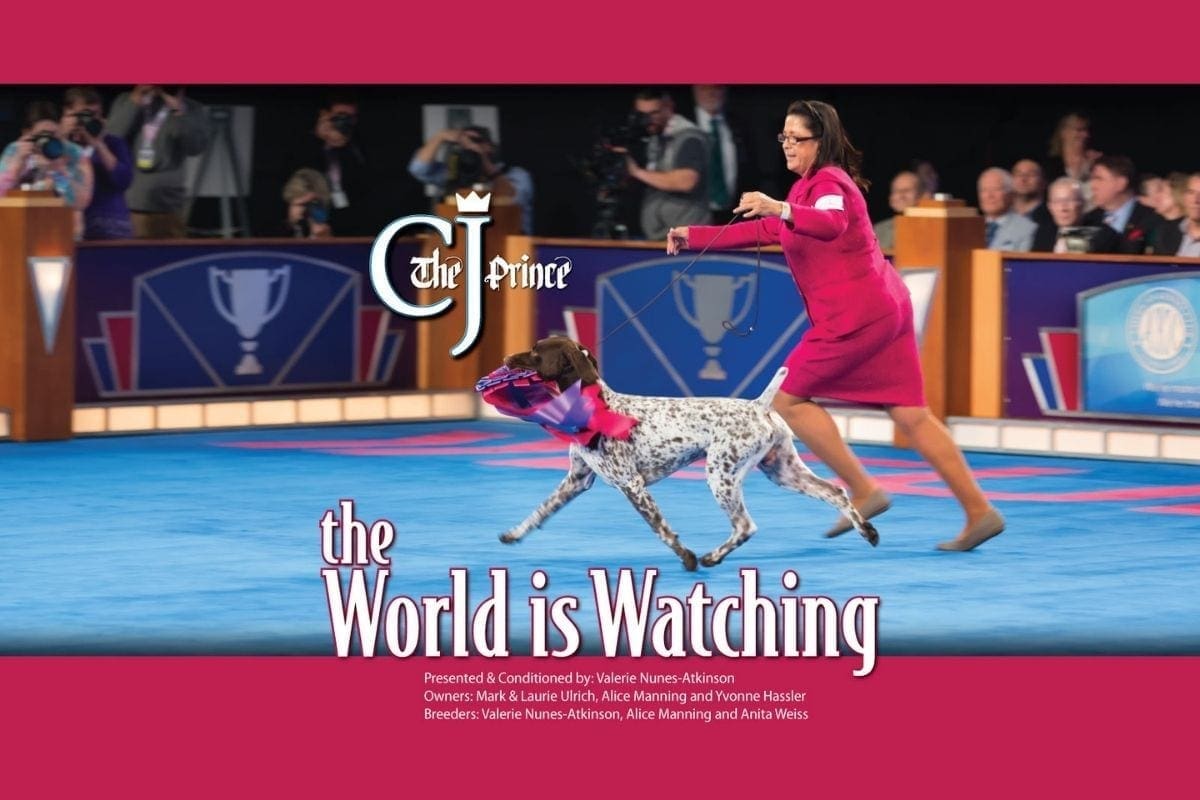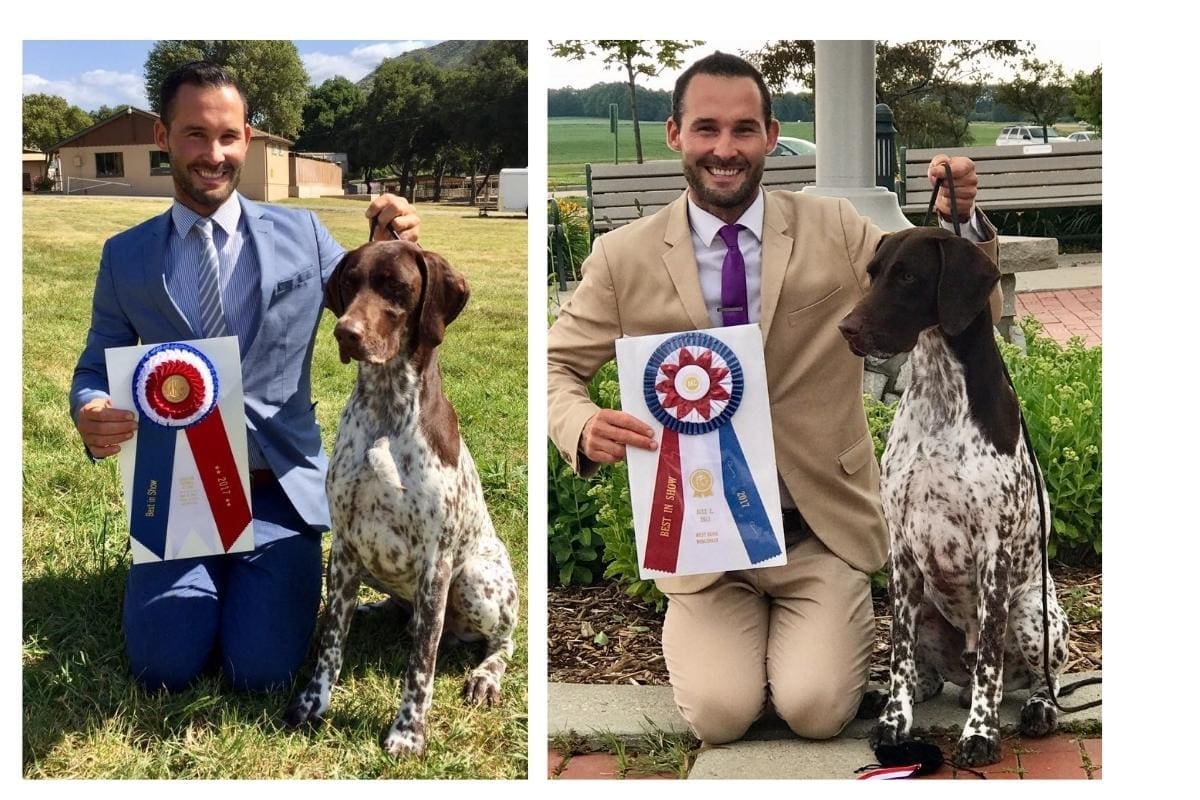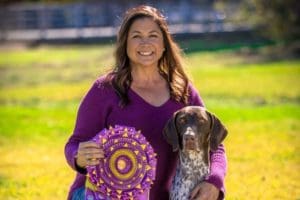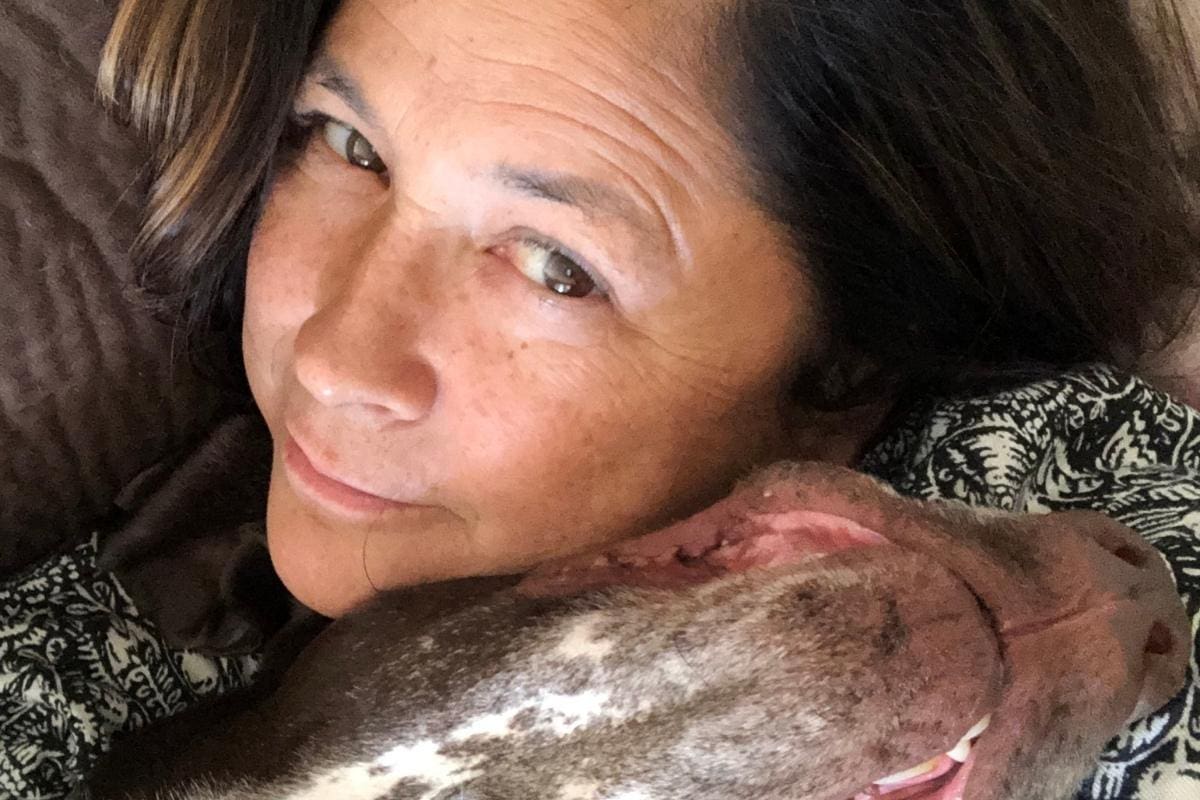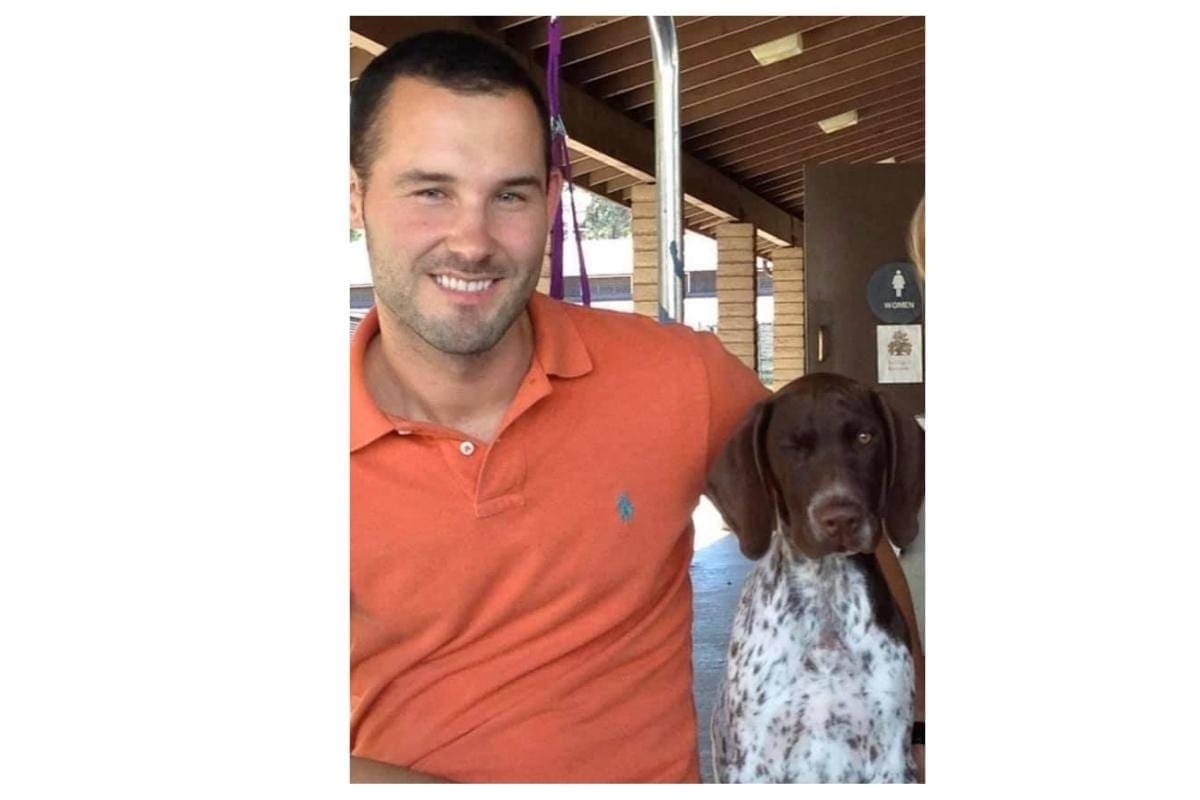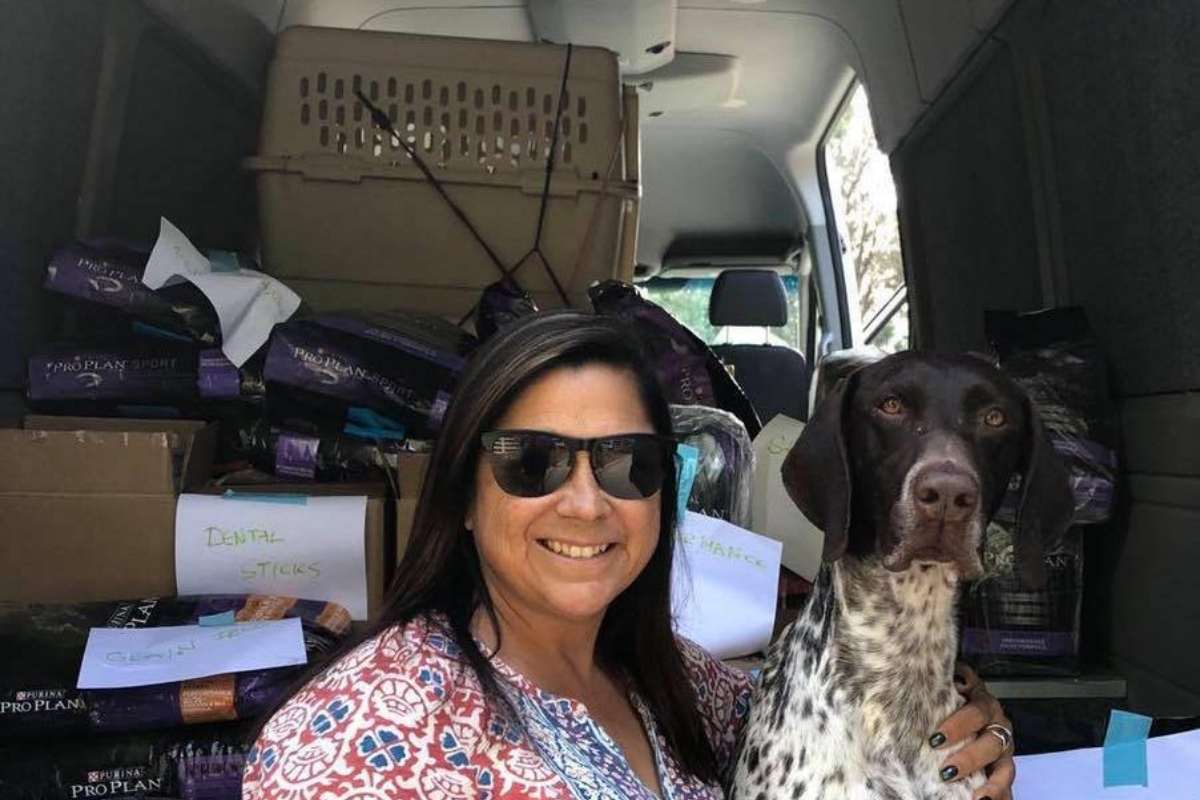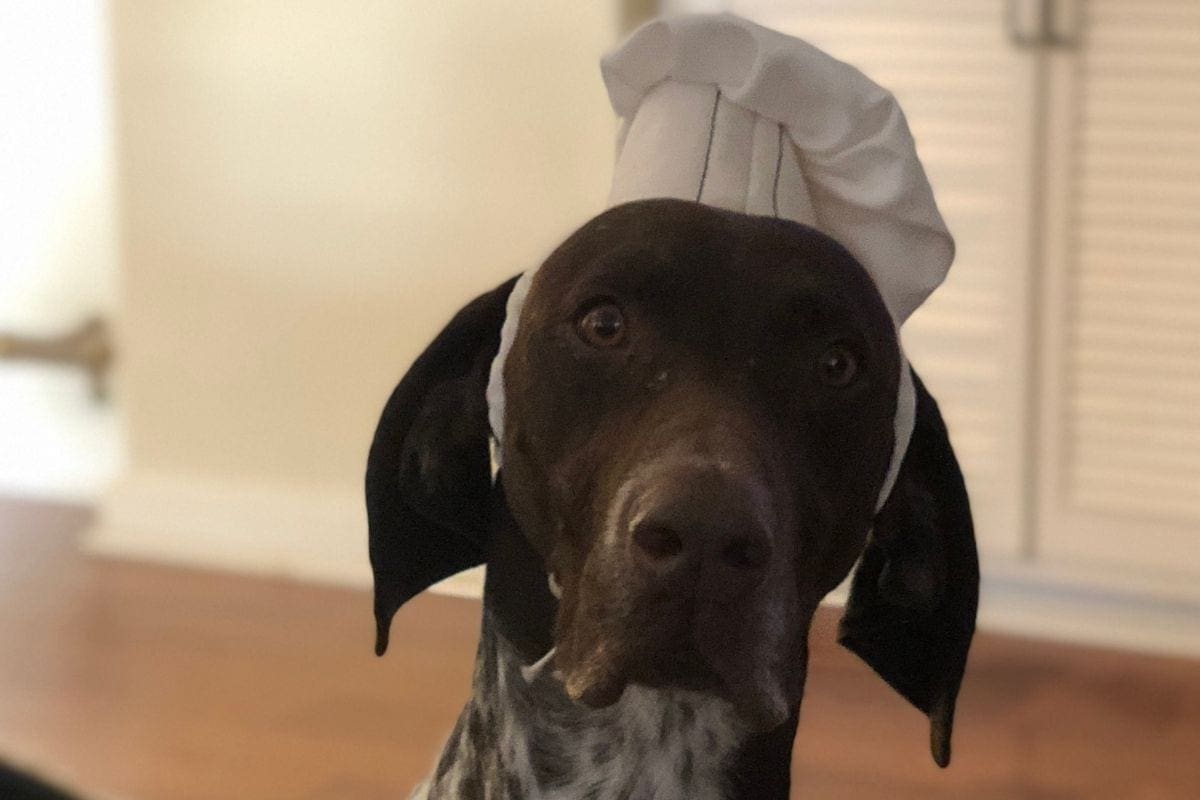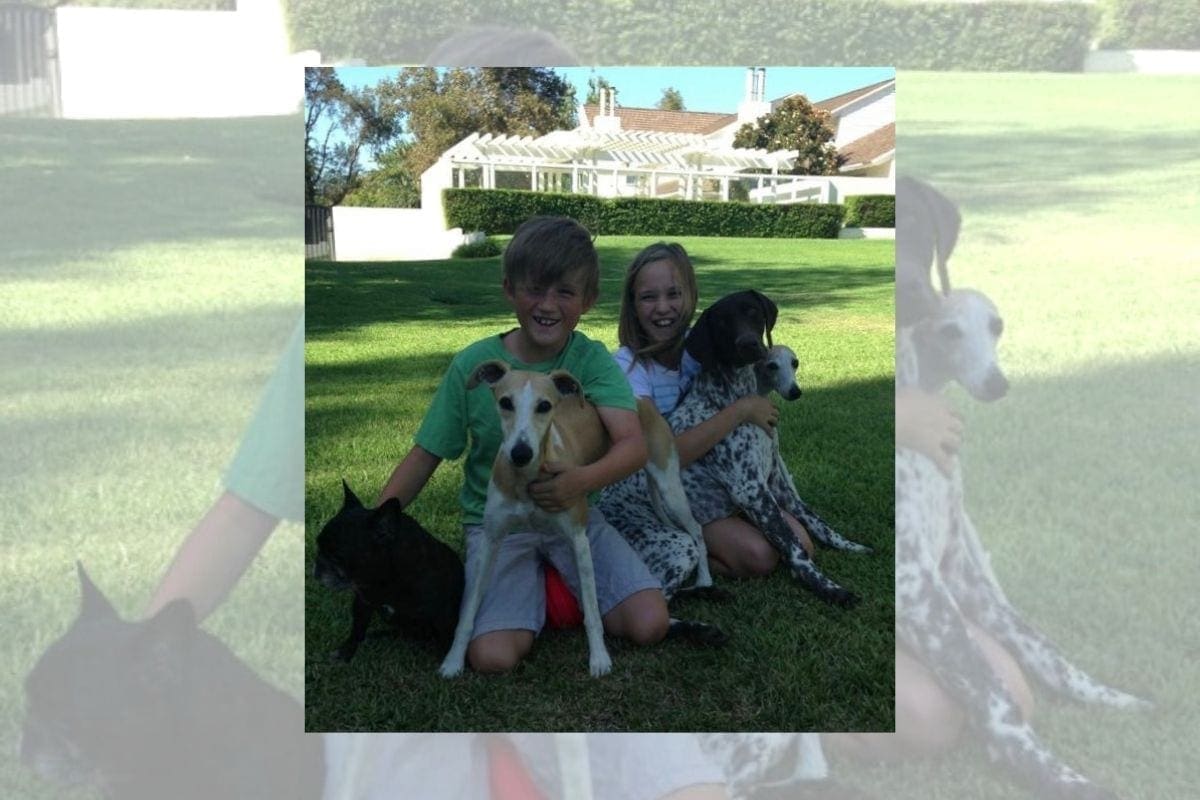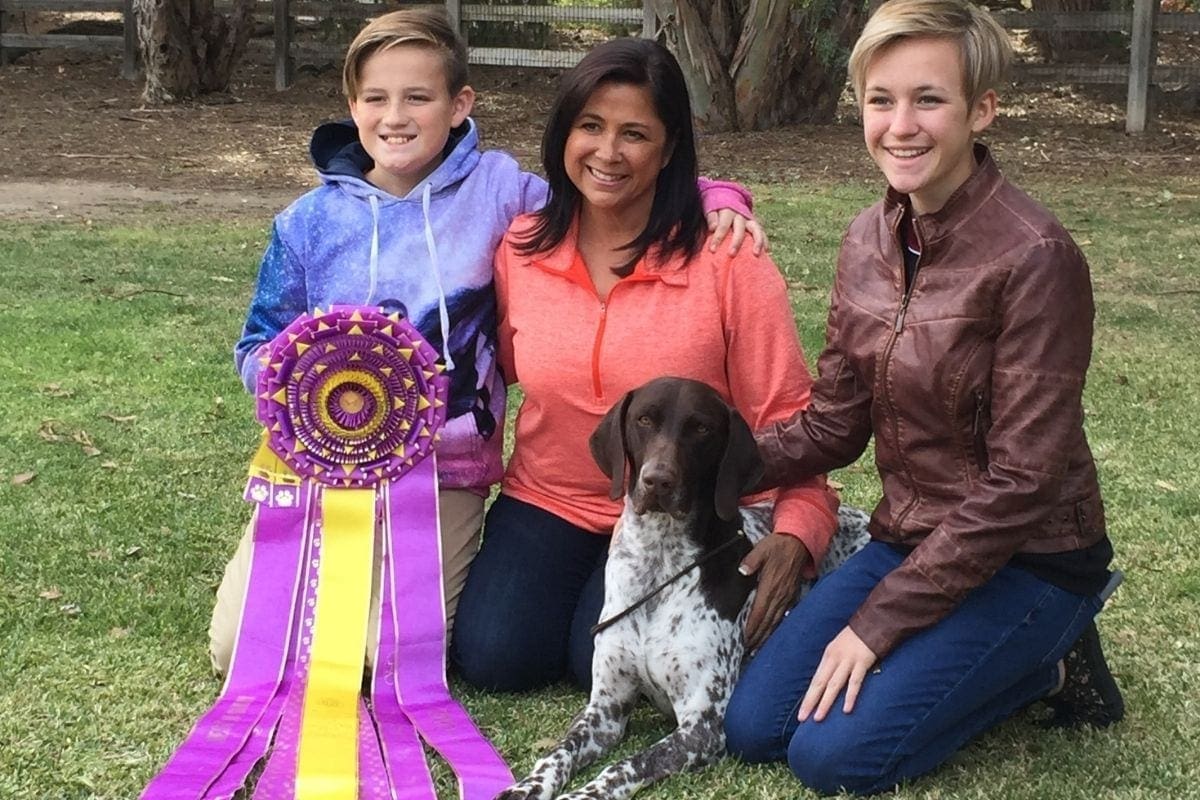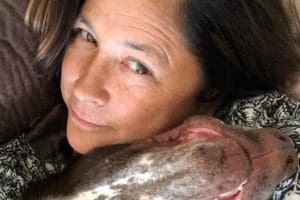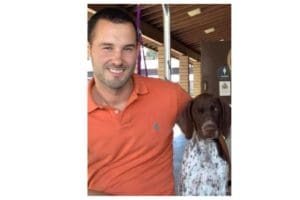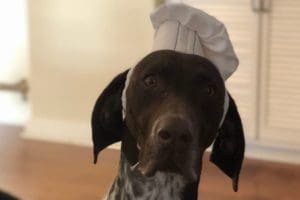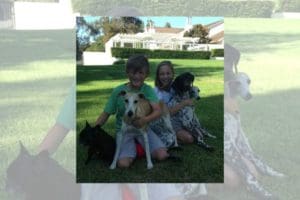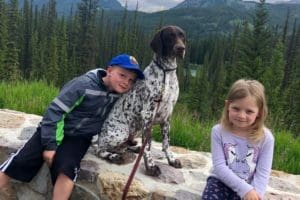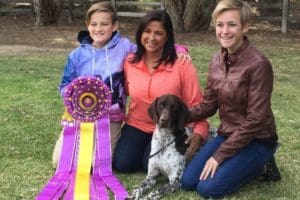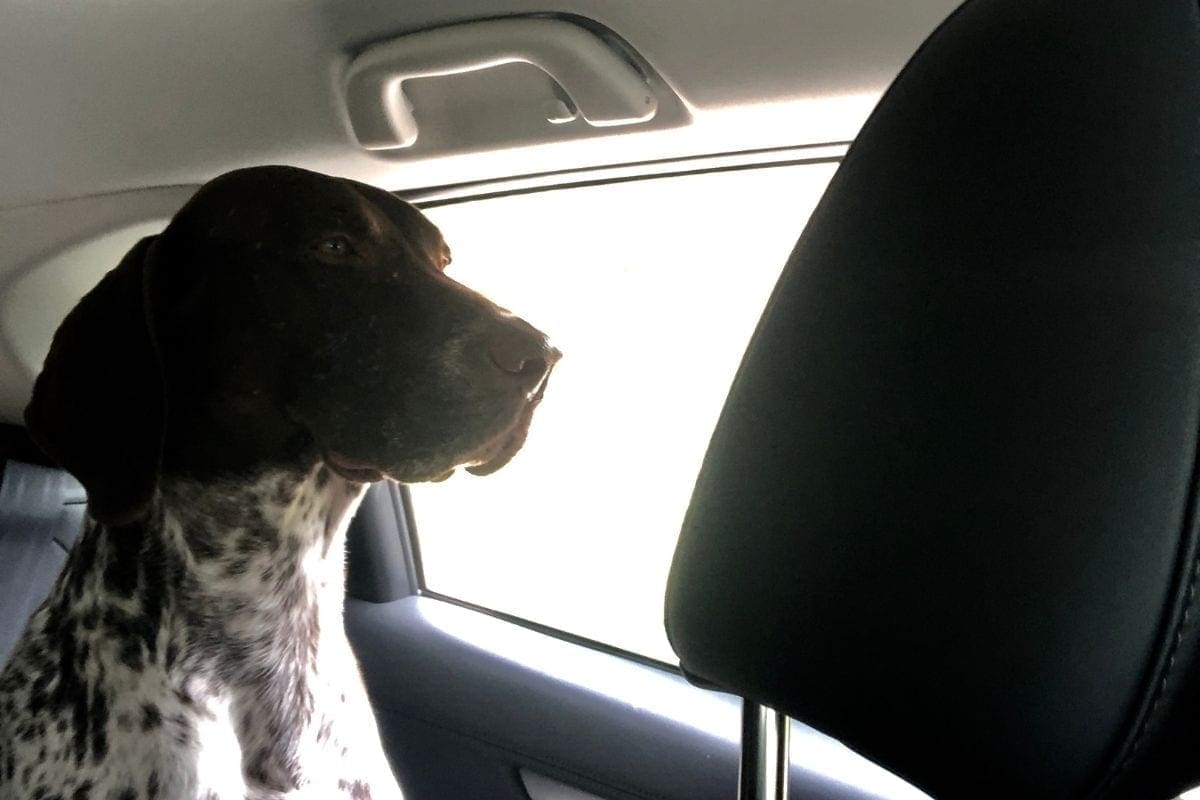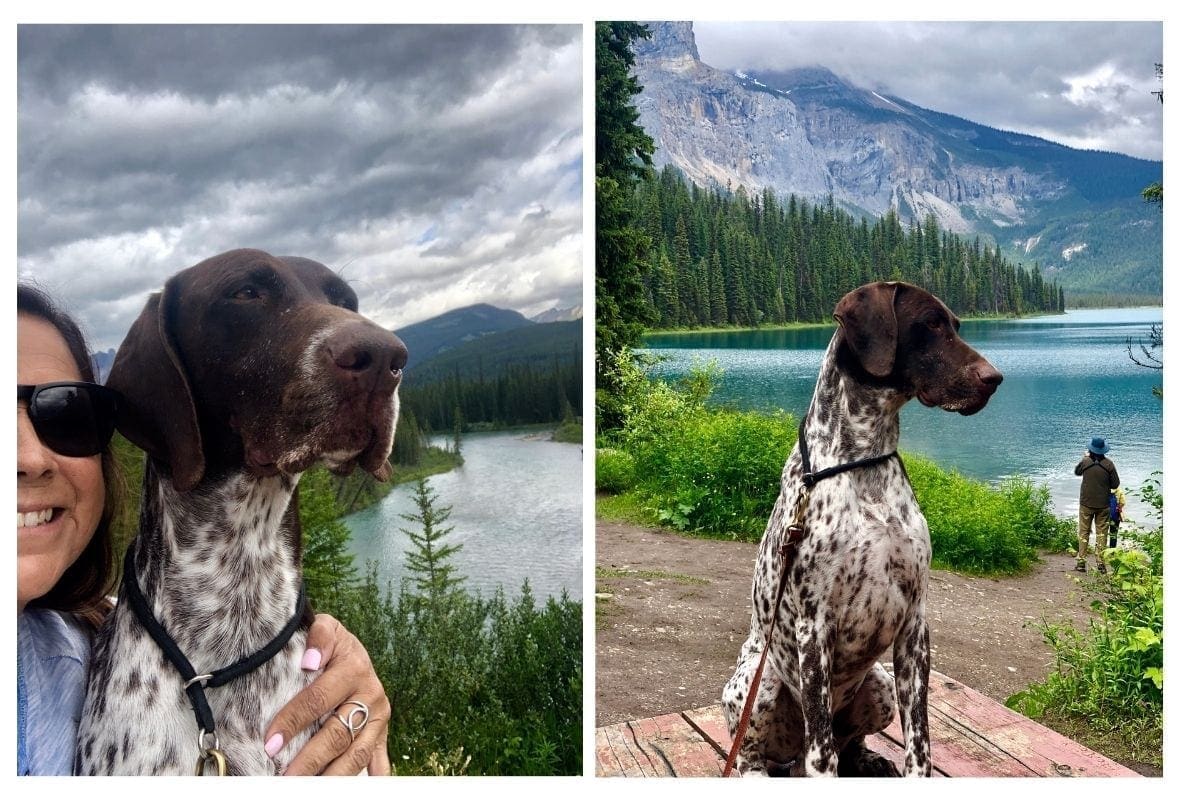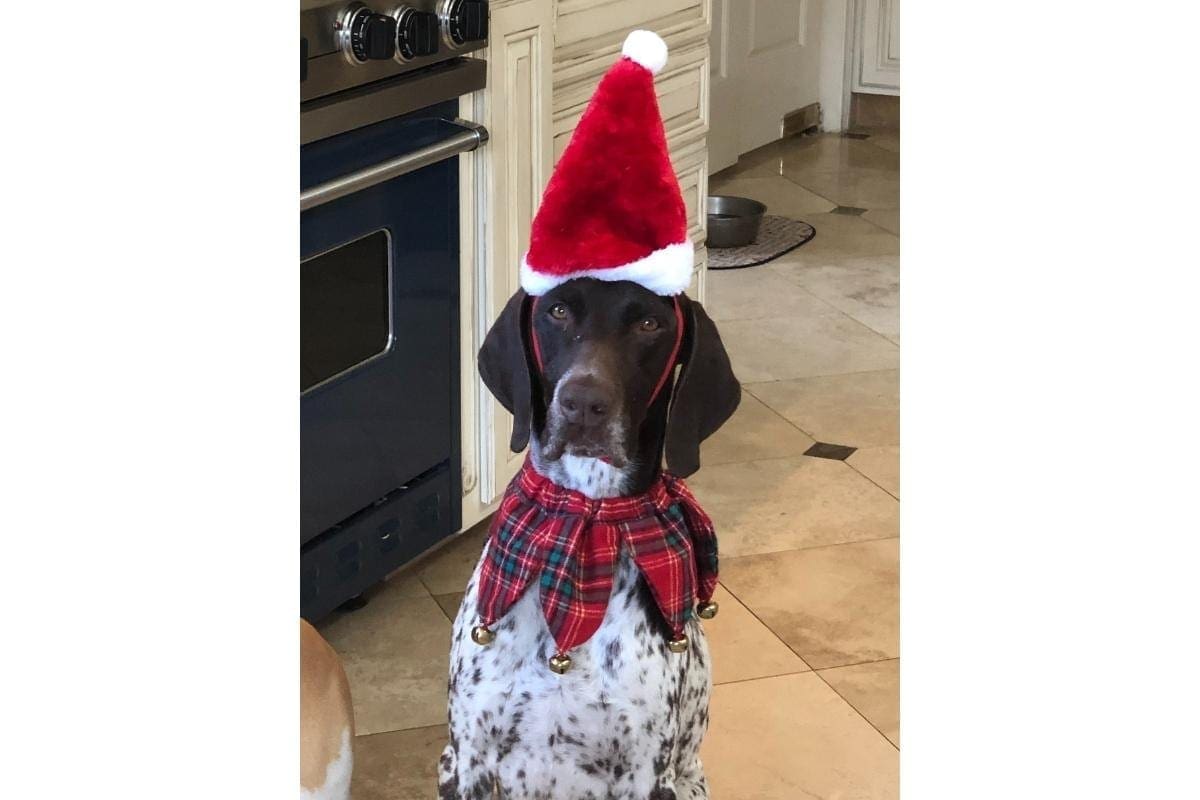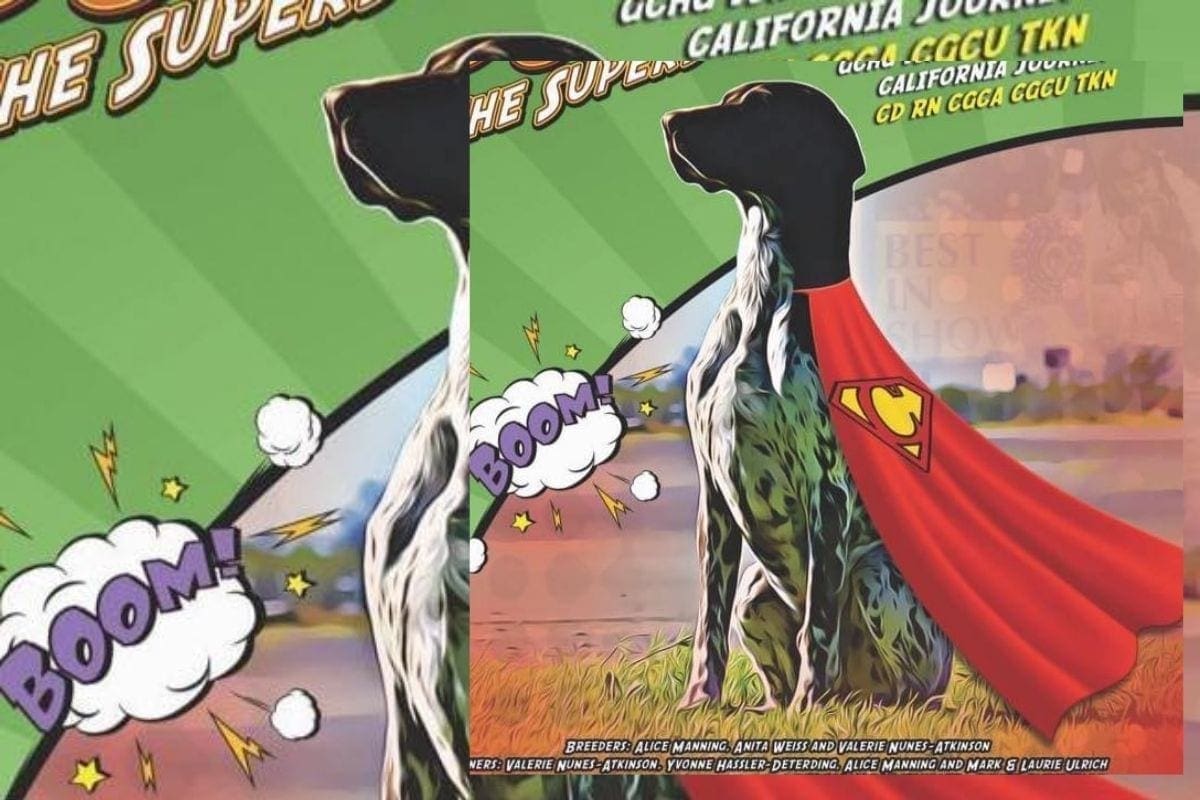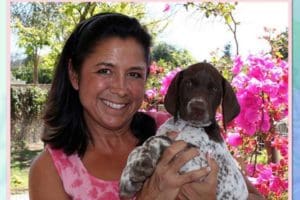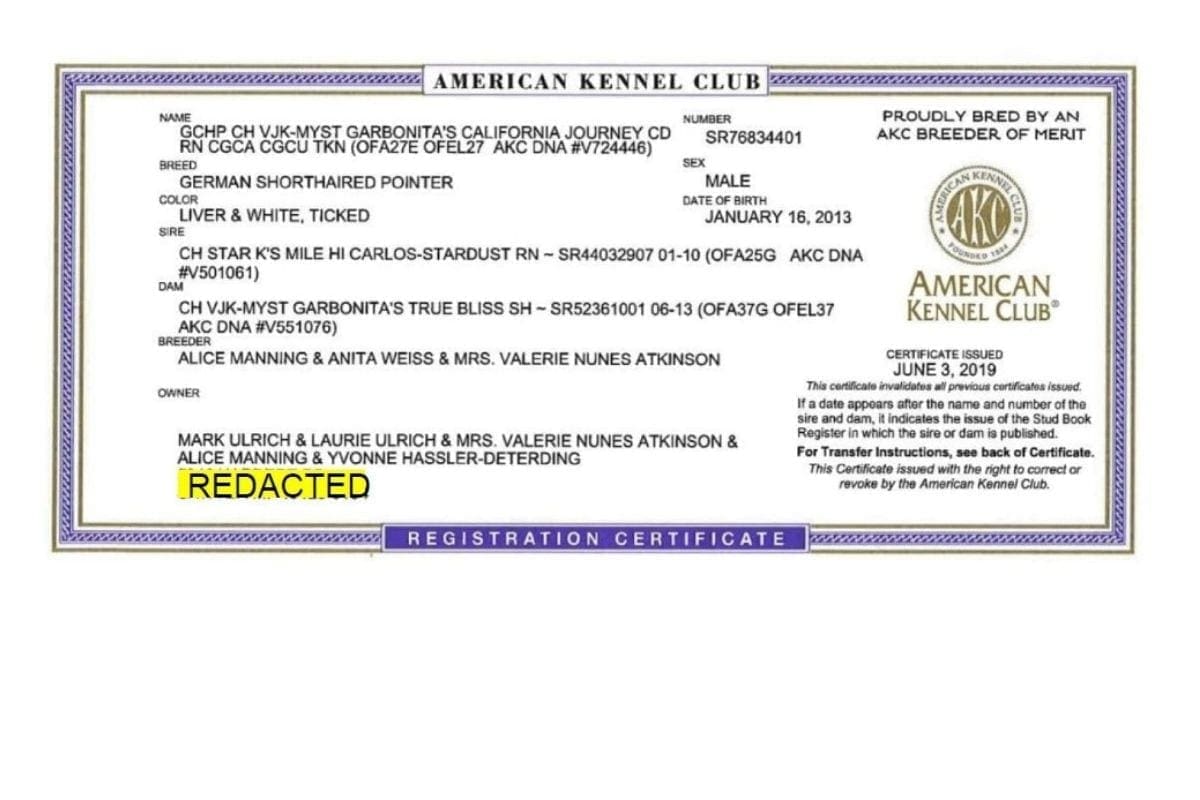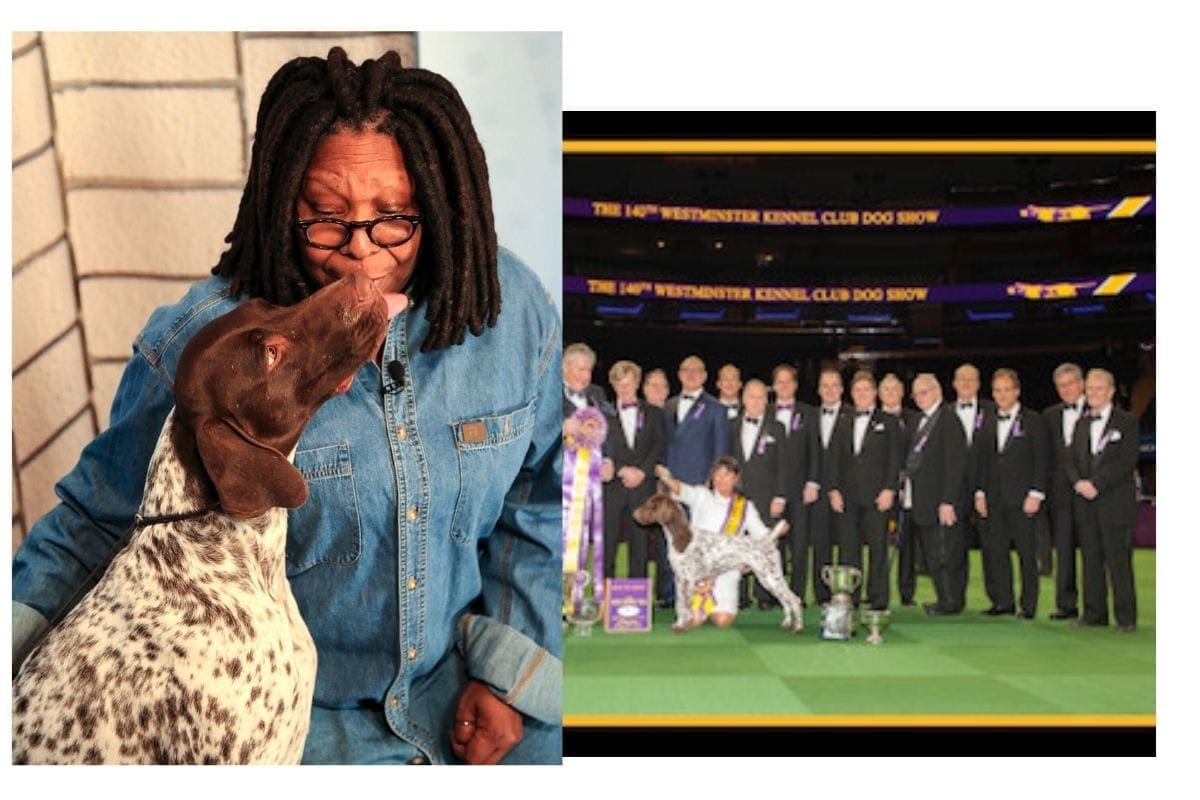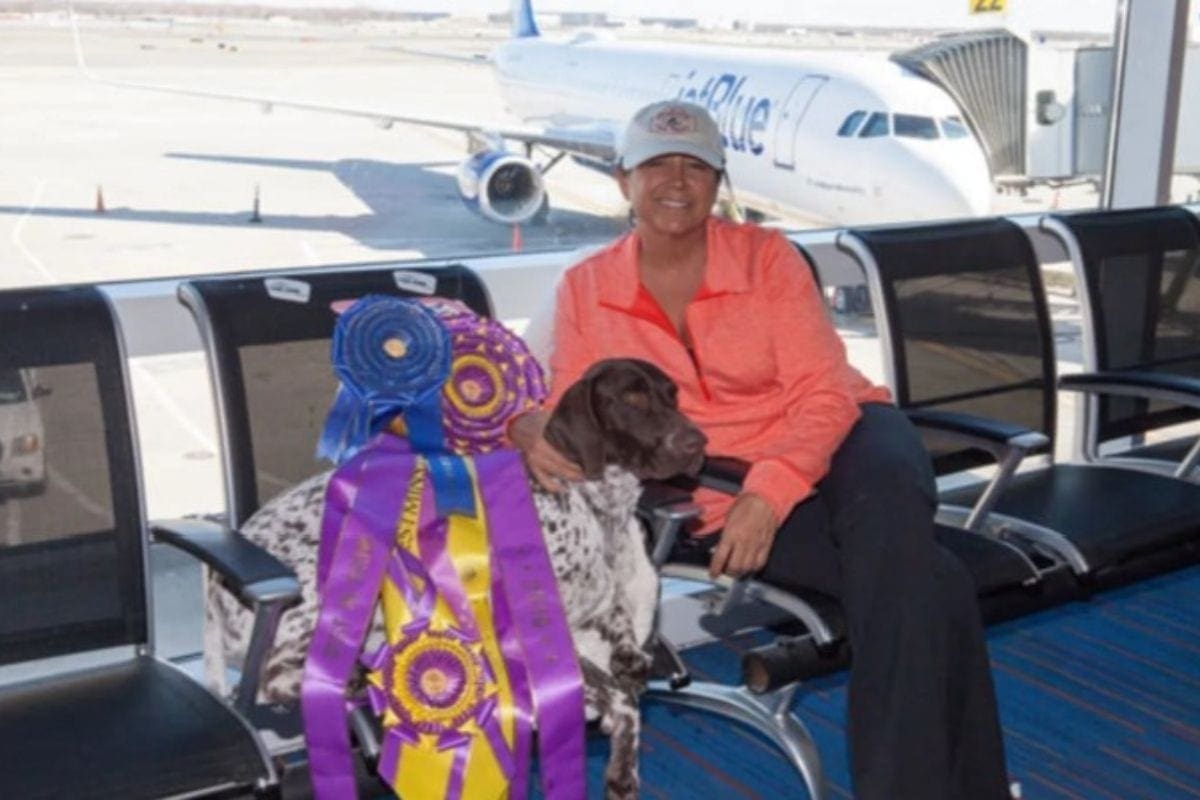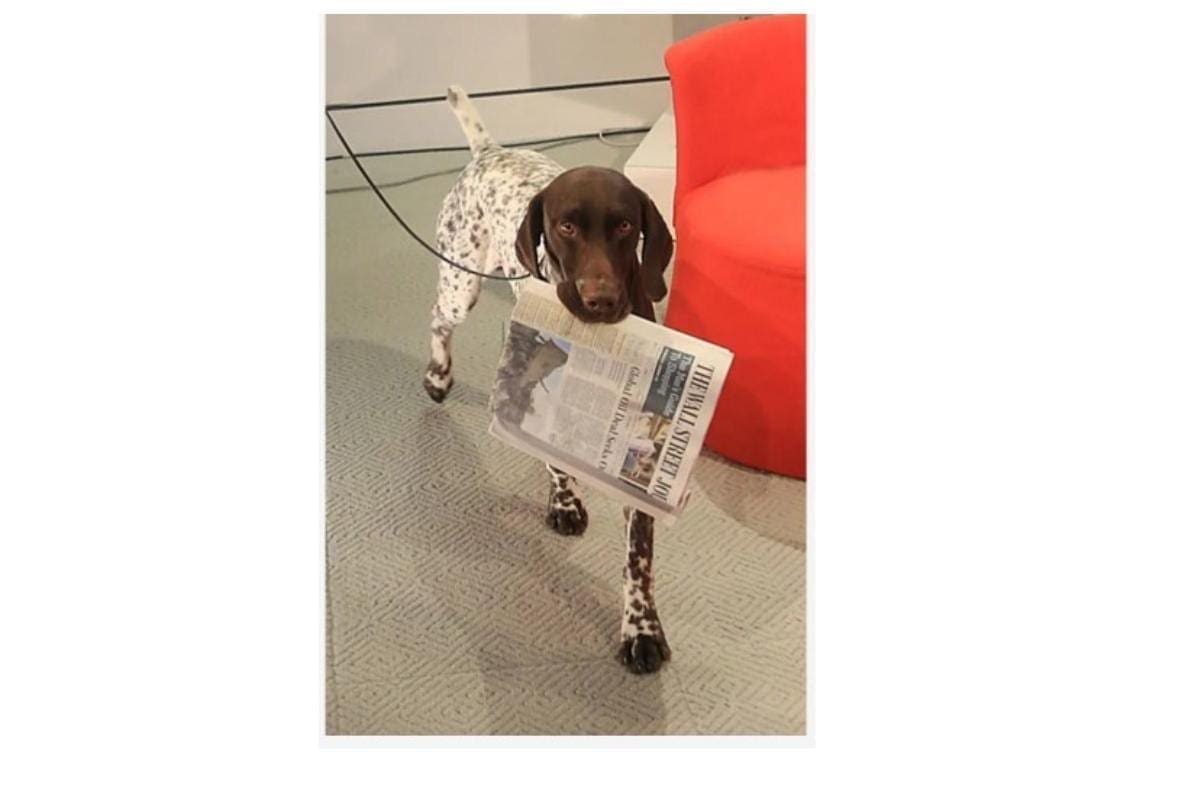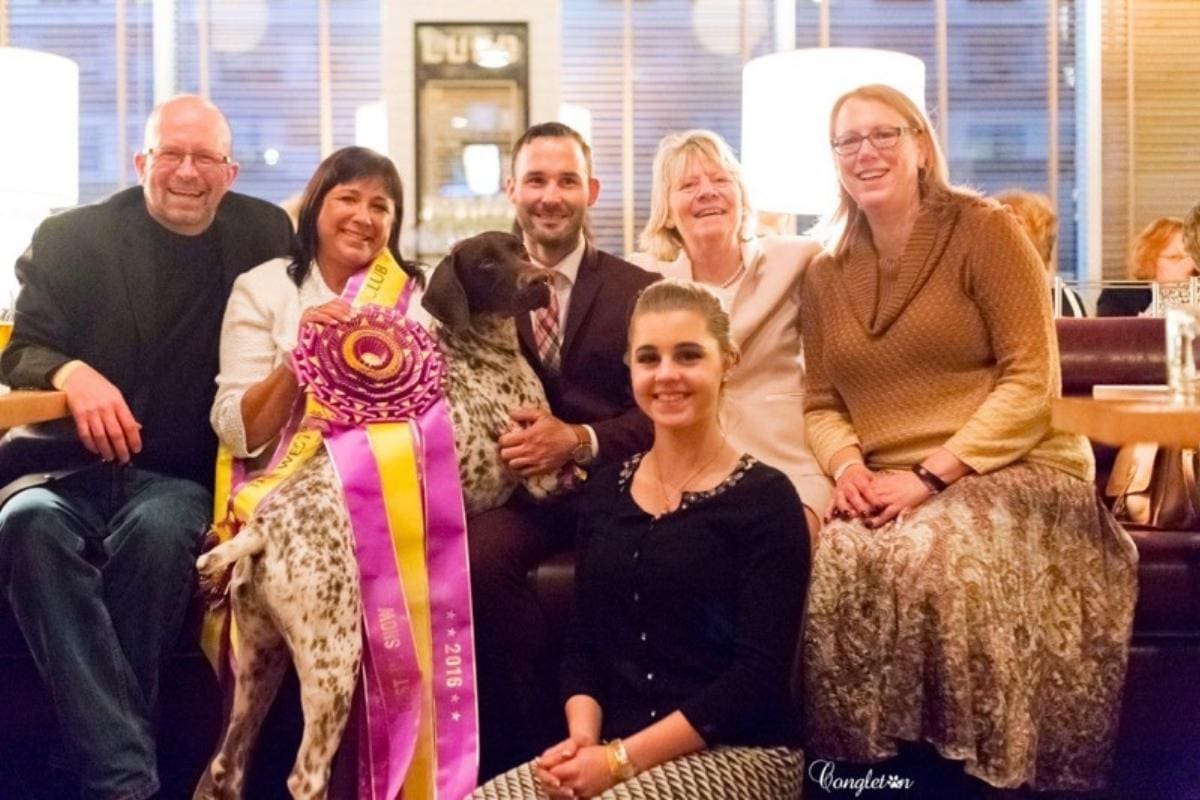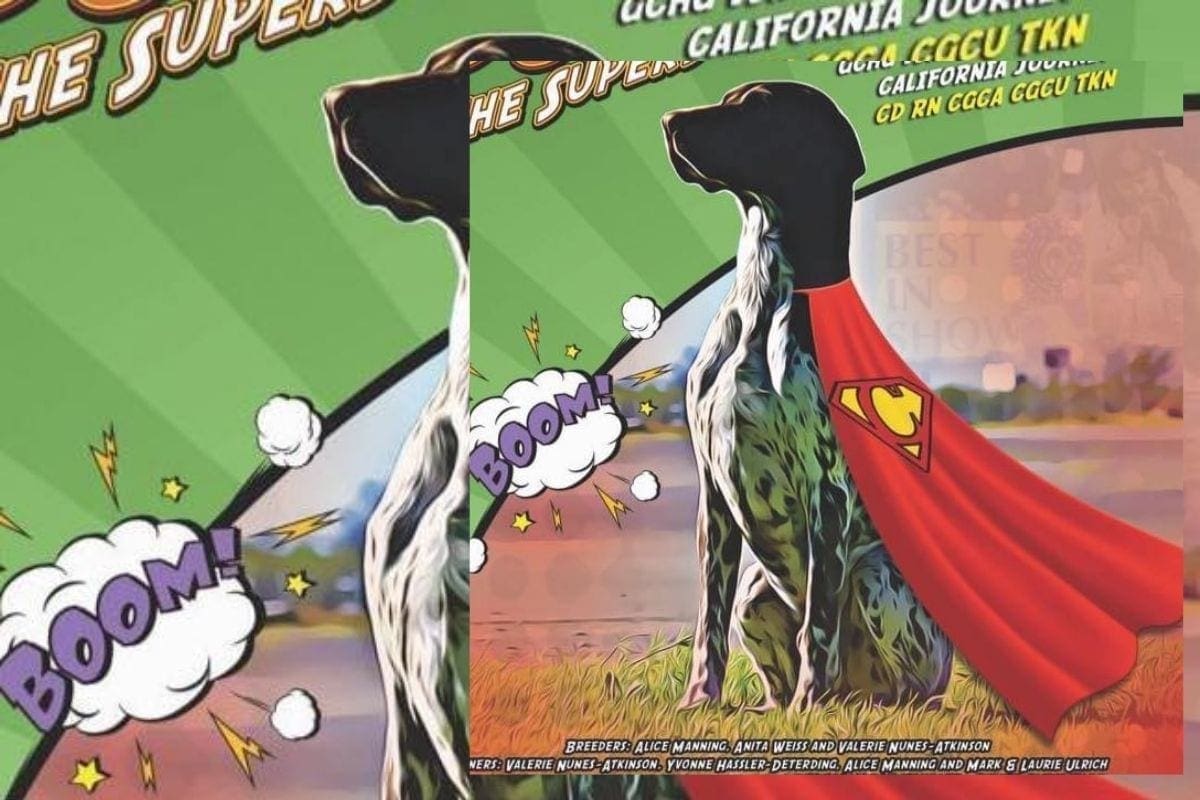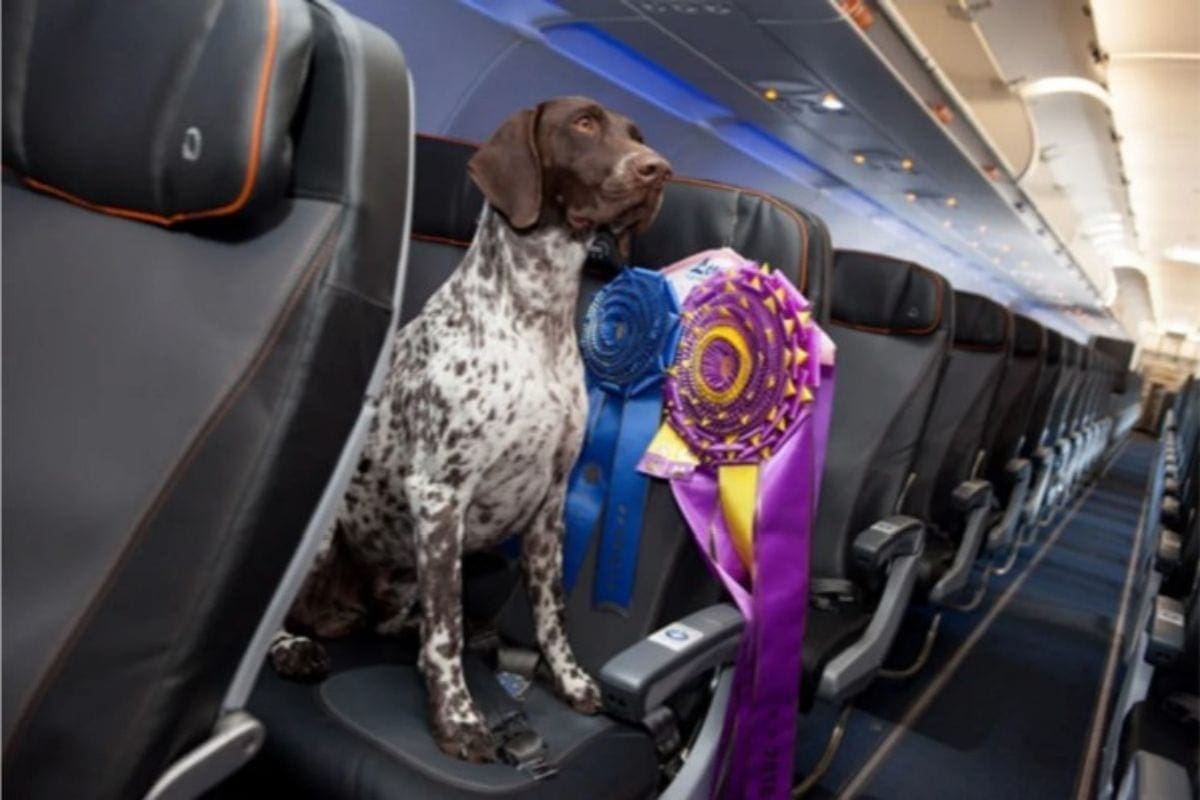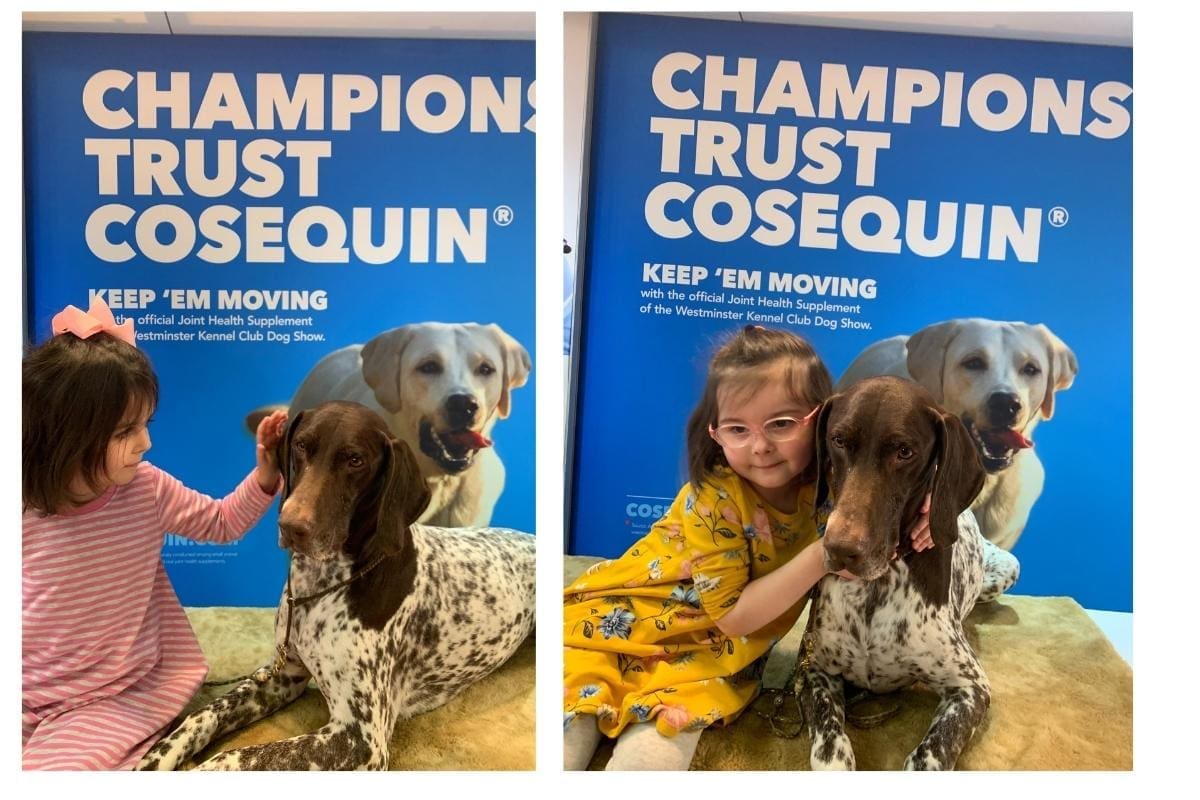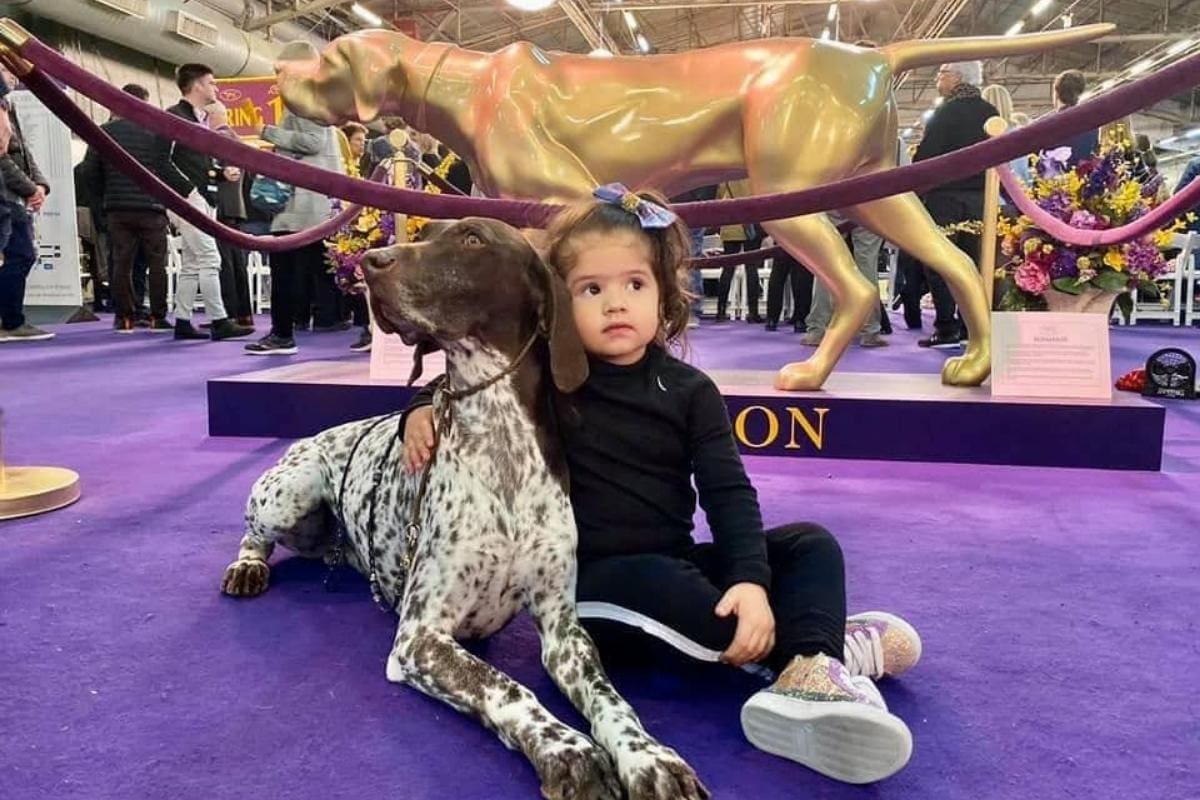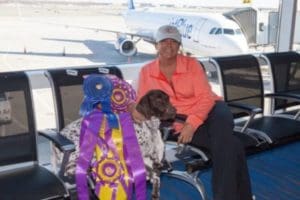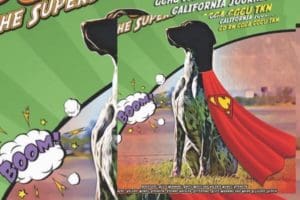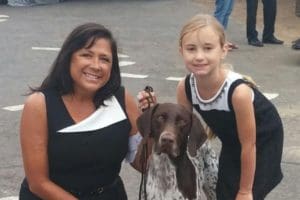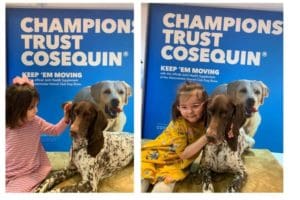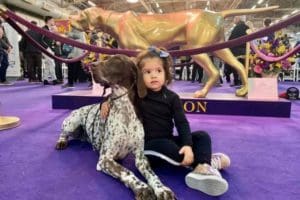Beloved best in show and ‘born winner’ CJ dies at 7
“CJ” (GCH Vjk-Myst Garbonita’s California Journey), a 7-year-old male German Shorthaired Pointer who won the most prestigious title in the canine universe in 2016 – Best in Show at the 140th Westminster Kennel Club Dog Show, winning against 2, 706 other dogs competing – died last month on September 21 at home in Temecula, California. His co-owner, handler, and soulmate Valerie Nunes-Atkinson was by his side along with her son Garrett, 16. CJ’s best canine friend, Ramona, a Whippet, and best feline friend, Tootsie were also at his side, according to Valerie. According to CJ’s veterinary neurologist, CJ’s case was “complicated from the beginning.”
In an interview with TCR, Dr. Vurick said she believes that CJ died from coinciding illnesses: lymphoma, which weakened CJ’s immune system and left him vulnerable to a secondary, opportunistic illness, cryptococcus, a fungal disease found worldwide that can be contracted by ingesting or inhaling tiny particles from bird droppings. Though much more common in cats, the disease is also sometimes seen in dogs and people with autoimmune diseases or weakened immune systems.
“The moment was what dreams are made of,” Valerie wrote the day after CJ’s passing about a photograph that is particularly ethereal from the night CJ was crowned Best in Show. In the photograph, Valerie can be seen taking a victory lap with CJ at Madison Square Garden, and all four of CJ’s legs are clearly suspended, floating on air. What becomes apparent to anyone scanning Valerie’s collection of photographs is that as talented and disciplined as CJ was in the arena, he was equally as engaged in life outside the show world. He spread joy far beyond the show rings and bright lights of Westminster.
German Shorthaired Pointers have a life expectancy of 10-12 years, according to the American Kennel Club. Before late June of 2020, CJ was “a vibrant, perfectly conditioned dog,” Valerie told TCR. In fact, CJ was still doing commercials for Cosequin, a joint supplement for dogs up until around the time he fell ill this summer.
His untimely passing sent shockwaves through the dog world and beyond.
The Patient "It started with one little, tiny yelp..."
“I never thought that within a month to six weeks, he would be gone.”
“It started with one little, tiny yelp getting up from a dog bed in my office,” Valerie recalls. It was at the end of June. “I thought, ‘Well, maybe his leg’s asleep or tingling or something,’” she explains. The following day, Val says she saw “a little bit of lameness on his right front and maybe a little bit of what we would say is like a sore neck or pinched nerve..a little off, but not super bad.”
It took Valerie a few days even to realize that CJ needed to see a veterinarian. After two days passed with no improvement, she knew they needed to get in to see their regular veterinarian, Dr. Cortez.
Jonathan Cortez, a staff veterinarian at VCA Yorba Regional Animal Hospital in Anaheim, was CJ’s primary veterinarian and says he has been working with Valerie for about four or five years. According to Dr. Cortez, who spoke with TCR by telephone, CJ had no known underlying health conditions when Valerie first noticed symptoms in late June. In fact, Dr. Cortez pointed out that even when Valerie brought CJ to him in late June and CJ presented with lameness, lethargy, decreased appetite, and hematuria (blood in urine), there was nothing remarkable in any of CJ’s laboratory tests.
What followed was an emotional rollercoaster of more than two months of veterinary diagnostic tests, procedures – almost all of them coming back without answers except to say what was not causing CJ’s symptoms.
As soon as they arrived at Dr. Cortez’s practice in Anaheim, Valerie says she saw CJ urinate “pure blood.” Dr. Cortez confirmed Valerie’s description of CJ’s case presentation, including the blood in CJ’s urine. “When I initially encountered [CJ], I never thought that within a month to six weeks, he would be gone,” Dr. Cortez says. “I assumed that he had been a healthy, active dog and he maybe slipped running down the stairs or something like that. I was not expecting this to be the outcome for sure.” Dr. Cortez says he works with “a number of local southern California handlers and show dogs and breeders” and respects the preservation breeder community. “But, to come across a dog of [CJ’s] stature is not an everyday occurrence. So, I was highly honored with Val’s confidence and trust to reach out and come to me. It was a once in a lifetime thing.”
While CJ was mired in diagnostic tests, procedures, and continuing to have symptoms, including blood loss – Valerie says she thought CJ was bleeding out at one point and rushed him to the emergency room –Valerie began reaching out to specialists throughout the country, forwarding copies of CJ’s records to friends in the show world who were forwarding the records on to their doctors. Valerie says she was hoping that someone would have an answer. “Someone had to have an idea that someone was not thinking of,” Valerie explained. Diagnosing CJ became her “full-time job.” she said. CJ continued to show symptoms, which appeared to be worsening, she says. For example, she noticed that he had started sleeping in strange positions such as on hard floors as opposed to his bed, which he had not done in the past.
Dr. Cortez could not find anything remarkable on any test. None of CJ’s lab results raised any red flags. Still without answers, Valerie –still soliciting input from veterinarians all over the country and, now, trying to get CJ an appointment with a neurologist to schedule an MRI – brought CJ to Ashley Ponteres, a board certified internist who suggested that they repeat Dr. Cortez’s tests and check for discrepancies. There weren’t any. Dr. Ponteres performed a range of additional diagnostic procedures, including arthroscopy, and abdominal ultrasound. According to office staff, Dr. Ponteres was away on vacation and could not be reached for comment.
Valerie describes still more frustration:
“His organs looked good. We still didn’t know why he was bleeding. Finally, they went back and put him under and scoped him – his urethra – checked all that out. There was nothing…The prostate looked good, everything..I mean, there was no cancer to be seen anywhere in his body, which was a great sign. We were thrilled. I have this healthy dog. And, I mean, healthy in terms of nothing was showing on anything. He was not well. He didn’t want to walk around. He was maybe more the lethargic. He was starting to have issues eating.”
By the time CJ showed up at veterinary neurologist Kelley Vurick’s office, he had already been “worked up to the nines” as Dr. Vurick said, speaking by telephone with TCR. CJ continued to present with hematuria (blood in his urine), lameness, and soreness in his neck. “We went ahead and did an MRI and we found enlargement in his brachial plexus…Most of the time, that’s either caused by cancer or neuritis.” Next, says Dr. Vurick, “we ran the cryptococcus test [the precise name of the test used to diagnose CJ was a latex agglutination test, according to Dr. Vurick]..to see if that might have been a cause for not only the enlargement of the nerve, but some of these other symptoms like blood in the urine that we were not able to find, and if maybe the cryptococcus was hiding somewhere else and we just couldn’t find it.”
CJ’s case was “complicated from the beginning,” Dr. Vurick says. She submitted the cryptococcus test on July 31 and the diagnosis came back on August 3, about a month after CJ first started having symptoms.
Cryptococcus or cryptococcus neoformans “is a fungus that lives in the environment throughout the world,” according to the U.S. Centers for Disease Control and Prevention. “People can become infected with C. neoformans after breathing in the microscopic fungus, although most people [and dogs] who are exposed to the fungus never get sick from it.” The disease is most common in people who have an underlying condition that is causing their immune system to weaken.
“It wasn’t pigeons,” Valerie says. “What we did have in the spring of this year was a family of hawks that built a nest in my tree that is in the center of the grass in my backyard, where the dogs go to the bathroom. And they built a nest, and they had two babies.” Valerie says she “wanted them out because I have never, in my life seen so much bird poop in my backyard.” However, her children insisted that the nest be allowed to remain with the baby hawks, so Valerie agreed to hold off, a decision she says she now regrets.
Following the positive cryptococcus test result, Dr. Vurick says CJ was put on antifungals and anti-inflammatory steroids. “I think it was a couple of weeks later, two, three weeks later, that he started to get those nodules under the skin. And we brought him back in, we did biopsies of the nodules, and he also had an enlarged testicle at the time. And that’s when he was diagnosed with the round cell neoplasia [lymphoma].”
In hindsight, Dr. Vurick says she wonders if CJ had the round cell neoplasia all along. “I’m honestly wondering if he had the round cell neoplasia all along, we just couldn’t find it anywhere, and the cryptococcus was a secondary infection. . an opportunistic infection. That if he had the round cell neoplasia, it would be compromising his immune system, compromising his body anyway, it would have given the cryptococcus an opportunity to get in.”
“I’m honestly wondering if he had the round cell neoplasia all along, we just couldn’t find it anywhere, and the cryptococcus was a secondary infection. . an opportunistic infection. That if he had the round cell neoplasia, it would be compromising his immune system, compromising his body anyway, and it would have given the cryptococcus an opportunity to get in.”
Southern California does see a handful of canine cases of cryptococcus each year, Dr. Vurik told TCR, noting, however, that the disease is much more common in cats. “We recently had another dog in the hospital with cryptococcus and encephalitis. We don’t see it frequently, but we do see it from time to time.”
Ann Hohenhaus, who is a specialist in veterinary oncology and small animal internal medicine, has been a staff doctor at New York City’s Animal Medical Center for more than two decades. Dr. Hohenhaus says the hospital’s neurology department sees about one case every year of cryptococcus in dogs (worth noting that the hospital treats 55,000 patients per year on average). Asked what she would say to dog owners trying to make sense of CJ’s story, Dr. Hohenhaus says that it’s worth considering analogies between CJ’s case and that of Buddy, the 7-year-old German Shepherd and first confirmed canine SARS-CoV-2 case in the United States that died over the summer. Both were large breed, middle-aged dogs with no known underlying health conditions. Most important, both dogs were diagnosed with lymphoma in the final days of what had been a months-long struggle to diagnose and treat progressive symptoms.
“I think [Buddy’s case] and this one probably both represent the interplay between cancer, the immune system, and infectious disease,” Dr. Hohenhaus says. “We will never know which came first in either case, but from my standpoint, when pets have a weird infection, I always worry about an underlying cancer and if the pet has cancer, we become obsessed with infection.”
“You want to keep your dog away from pigeon poop,” Dr. Hohenhaus says for the New Yorkers reading. “And that’s a reason not to let pigeons roost or feed pigeons. Like, pigeons aren’t endangered!” Dr. Hohenhaus added. “We shouldn’t worry that much about them. Do not let pigeons into your apartment. Do not feed pigeons because pigeons poop and poop has crypto in it.”
Valerie wishes for all dog owners to know that it’s not only an issue of pigeon droppings — and she’s right. All bird droppings can carry cryptococcus. Still, cryptococcus shouldn’t be your only concern, Dr. Hohenhaus warns. “If you’re a dog owner, you probably should worry more about Aspergillus ” [a common mold that can cause people and animals with weakened immune systems to become sick], which she says is seen more often, at least at the AMC in dogs than crypto. “And [aspergillus] might be in the pigeon poop, too, so double good reason not to fraternize with pigeons.”
While cryptococcus is more common in cats, the type of cryptococcus CJ contracted, which affects the central nervous system, though uncommon in dogs, has an extremely poor prognosis when dogs do contract it. Dr. Hohenhaus says any place where birds are roosting, such as caves, should be avoided by people as well as dogs, “because where there is roosting, there is poop.”
“I think the Staten Island case [referring to Buddy, the first dog in the U.S. to test positive for SARS-CoV-2 and died several weeks later] and this one probably both represent the interplay between cancer, the immune system and infectious disease..”
“It’s interesting how what you want changes. Before, I wanted him to run and gallop across my property like he had. Once I realized that was never going to happen, I just wanted him to be happy and have a good quality of life and not be in pain. As long as he could go to the bathroom and enjoy his food and not be in pain and enjoy his family, that was okay.”
The Heartbreak Last Days
As soon as the nodules appeared, Dr. Vurick says a dermatologist took biopsies that eventually led to the lymphoma diagnosis. Next, Valerie says she found herself with an oncologist and CJ was started on “a very lightweight kind of chemo shot” simply to double down on diagnostics.
Valerie recalls the experience of learning about the lymphoma:
“If we see a result from that [shot], we know it’s lymphoma,” Valerie explains. “So, within a day, the testicle had gotten smaller. And, sure enough, the test came back as some kind of t-cell lymphoma. The bottom line to the whole thing is, he got the cryptococcus which attacks his immune system. You can’t fight the cancer without killing the immune system. So, we can’t really do anything. We’re trying to walk a very thin line. We put him on prednisone because that’s where we had seen some results with him having a better quality of life, but we had to be careful because that kills your immune system. So, we were on this very fine line. All of the lumps basically disappeared. His testicle went back to normal. He was walking and trotting around. And then in the last week or two weeks before he passed, it was pretty good. I mean, it’s all relative. It’s interesting how what you want changes. Before, I wanted him to run and gallop across my property like he had. Once I realized that was never going to happen, I just wanted him to be happy and have a good quality of life and not be in pain. As long as he could go to the bathroom and enjoy his food and not be in pain and enjoy his family, that was okay.”
…About a couple days after that, I could see, ever so slightly, him kind of going down on the front end a little bit more…He was kind of starting to go off food. And everything I had going with the integrative vet went out the window. At that point, I was like, ‘You can eat whatever you want to eat. He’d lost some weight. So I got him back on his kibble. He wanted just to eat regular kibble. I’m buying all of this lamb and salmon and he didn’t want it. but he’s kind of going down on his front. He was on gabapentin every six hours.”
“I have a communicator that we deal with in the dog show world. She kind of helps us figure out some dogs. So, I had her read [CJ] … The bottom line was, she says he knew he was sick, he wasn’t in pain, that he wanted to go with his dignity. And that, for me, was everything, too.”
“I knew I wanted to be a day early, not a day late, in putting him down because I didn’t want it to be an emergency situation. I didn’t want him to be in pain.”
“The last week was when all of this was starting to go downhill,” Valerie says. “He stopped eating the night before. I could barely get anything in him; the next morning, he wouldn’t look at any food. I knew we were probably getting close. I didn’t think it was going to be that day, but I kind of knew.”
Her account continues:
“I always told my co-breeder, Yvonne, that I knew I wanted to be a day early, not a day late, in putting him down because I didn’t want it to be an emergency situation. I didn’t want him to be in pain. It’s hard because it’s really on you to make that decision. It’s hard. And he still – although he wouldn’t get up and walk around – he would lay there and sit up in a proper ‘down’ position, straight down so he would look at me, bright-eyed, ears up, wagging his tail. He just wouldn’t get up and walk around really that much anymore. He was very much that way that day. I took him out in the morning. His walking had gotten very bad. He could not. . I had to help him. His legs were crossing over in the front when he tried to walk..In the middle of the day, that’s where I told Yvonne, ‘I’m just going to check with some people because I’ll do an in-home euthanasia and see what’s available, who’s around, who’s available.’ I just kind of wanted to have someone have a heads up and so I talked to a couple of people and I took him out. That morning, I really helped him, and then he had trouble going to the bathroom and I just thought, he’s not going to go out like this.”
Remarkably, Valerie kept her composure and continued:
“I made some phone calls so I had a late appointment, like 630 or 7 with a vet.….I could hear him getting up, and so I walked into the room and he was standing there. He had a weird look on his face. So, I went over to him and he laid down and then he just was holding up his right front leg really, really high against his body and his eyes were – he was in pain. I didn’t know if he was having a stroke. That’s what I thought was happening. And then he laid kind of on the side, picked up his back leg, same thing, holding really tight that whole right side against his body, and eyes were wide, and I thought, we’re not going to do this. So, I had had another person I kind of had on call and she had an earlier appointment. So, I called her back and said, ‘You need to come now.’ And so that lasted about not very long. Maybe a few minutes and it wasn’t a stroke. He was fine after that. But I think it was cramps. I think there was some sort of spasm or something that had to do with cryptococcus.
I got him back on his bed and then he just laid there and that basically was where he was until the end. He didn’t have any more pain after that. I think that was purely a spasm. But I wasn’t going to – what does six more hours do? Or another day? That’s what you start to think about. And the bottom line was, we were not going to get him better. He was not going to get better. It’s heartbreaking. And then you think, ‘I love all my dogs, but why him? And why did he get the lymphoma?'”
“What does six more hours do? Or another day? That’s what you start to think about. And the bottom line was, we were not going to get him better. He was not going to get better. It’s heartbreaking. And then you think, ‘I love all my dogs, but why him? And why did he get the lymphoma?'”
How CJ and Valerie Ended Up Together Early Years and Home Life
CJ was whelped with nine other brothers and sisters on January 16, 2013. The litter was co-owned by Valerie, Yvonne Hassler-Deterding, Alice Manning, Mark Ulrich, and Laurie Ulrich. He was always “an old soul,” Valerie’s close friend Diane Stendahl of North Salem, New York said in an interview by telephone. Antonio Vidmar, who works with Valerie and was CJ’s second closest human, according to Valerie, also described CJ as an “old soul.”
CJ was “a most unusual dog” in the least pejorative sense; “part-human,” and with an uncanny ability to “tune-in,” Diane told TCR.
Valerie and Antonio often describe CJ in photographs as “Born this way,” and “Born winner.” Valerie explains it this way: “The poise it takes for a young, untrained dog with zero experience to go to those huge shows with all of those noises and energy and shine. He just did. It was natural to him.”
“Antonio, Val, and I, and probably some other people, too, have always joked around, years ago when he was young, saying, ‘he was born that way. He was born with it,'” Diane explains. “He was an old soul. He is an old soul…The thing that was so amazing about that dog — amazing isn’t the right word. Strange. Different. I don’t know. We would be in a public setting and people would flock to him. He was like a magnet….His connection to kids. Oh my goodness. It was just amazing. That dog, he was such an ambassador for our breed.”
“What was so incredible,” Valerie says, “was that as great as a dog as he was as all-time top winning GSP [German Shorthaired Pointer], he was just a cool, regular dog that loved kids, cats, dogs, getting dressed up at our house by my kids, traveling the U.S., starring in Cosequin commercials. Loved therapy work with the disabled, kids’ literacy therapy, had three CGC titles, Obedience, Rally, and Trick titles.”
A little known fact about CJ is that he and Valerie almost lived their lives apart. “I was supposed to take a female. I only take females. I never keep males,” she explains. “As a breeder, you don’t keep males. You can breed any male anywhere in the world, so you don’t keep boys. You only keep girls. And, so, I was taking CJ’s sister, Epic, the pick bitch…” Valerie says there was a ‘puppy party’ when CJ and his littermates were 8 weeks old (the point at which puppies typically separate and go to their permanent homes) for the co-owners of CJ’s litter. Valerie says Alice, another co-owner who was supposed to be taking CJ, the pick male of the litter, approached Valerie and asked if they could switch puppies because, she told Valerie, she had another, older male in the house and was concerned about adding another male. “And, so, she said, you take CJ, and I’ll keep Epic.”
Diane infamously disapproved of CJ when Valerie first told her about him and showed her CJ’s pictures. “He was horrible for his puppy pictures,” Valerie explains. “And I said [to Diane], just wait until you see him on the ground. You have to see him moving. Trust me.”
The other story Valerie wants people to know about CJ is that when CJ was four months old, Valerie’s now late friend Patti Crowley, a person Valerie refers to as an “animal communicator,” approached her at a dog show in Colorado and told her that Toby – CJ’s great grandsire and the last male German Shorthaired Pointer Valerie owned prior to CJ – had come to her and told her to tell Valerie that CJ was not him (Toby). “I had been thinking that the puppy might be Toby,” Valerie explained. “‘Tell Valerie that he [Toby] knows she has CJ and that he knows she thinks CJ might be him. He [Toby] wants to tell you,’ Patti continues, ‘that CJ is not him, but that he sent CJ to you. And that, that dog is a very special dog. And he sent that dog to you to make your heart sing and to make you happy again,’” Patty said to Valerie that day, according to Valerie.
“No one knew, supposedly, that it was Toby sending this dog to me,” Valerie added. “And then that dog turns out to be CJ that goes on to do all of these incredible things.”
“He was loved and gentle with all. Loved my house cat, Tootsie. And all dogs, male or female.”
On Facebook, Valerie has received thousands of heartfelt condolences, many with memories and stories of joining CJ on his adventures. “I had absolutely no idea the impact CJ had made worldwide,” Valerie wrote in a message to well-wishers following CJ’s passing. “There is no possible way to convey my gratitude for all your kindness and love you showered me in. From the bottom of my heart I thank you all for the THOUSANDS of messages, shares and flowers. Your tributes and pictures you posted of him brought me joy when I was on my knees….I’m blessed, honored and so grateful for you all to take time from your busy lives to help comfort mine, Forever humbled. Our house is empty, as you know he was a huge presence in our lives and hearts. Life won’t be the same, we know that. But we are so grateful for all of you in our family and sport. He was quite the character; he always had the most amazing eye contact, never looking away. He could read my mind and soul, I could read his. Those that knew him well would not have been surprised if one day he just started speaking. He didn’t have to though, his eyes told it all. In the end it was his eyes that told me it was time. I begged for more but knew in my heart it was time.”
Show Life "Born this way"
“He lived an entire life and a half of a life,” Valerie says. “Everything he accomplished, it was like he was on fast-forward. Who wins Westminster after just turning three years old? That doesn’t happen.”
It did happen: “This is the pinnacle. This is what we strive for,” she said at a podium to an army of reporters at a press conference following CJ’s win at Madison Square Garden. “The very best dogs in the world come here. This is the show to win, and I’ve dreamt about it since I was 10-years-old.”
Now, Valerie was the inspiration. “I was only 16 when I watched CJ and Val take on the biggest ring in dog show history and beat it,” Mekenzi Cecil wrote on Facebook. “As a young junior handler who, even though growing up with the breed still considered myself an amateur, watching this happen at such a crucial time for me was a time I will never forget. CJ lit such a flame for the breed and it hurts to see him taken from us so soon. However, his time spent contributing to the breed will not end any time in the near future. Not only is his story quite literally engraved in history, I’ve seen all of the posts and show results. His kiddos are keeping his flame lit for generations to come!”
“He lived an entire life and a half of a life,” Valerie says. “Everything he accomplished, it was like he was on fast-forward. Who wins Westminster after just turning three years-old? That doesn’t happen.”
Even before CJ won Best in Show at Westminster, he had swept up Best in Show titles at 18 other, smaller competitions, Valerie says. CJ also, perhaps, may have benefited from his DNA. His grandmother, Carlee, won Best in Show in 2005 at Westminster, making Valerie one of only ten owners in the history of WKC to win a Best in Show title twice, each time with a different dog.
“He never stopped looking, focused in front of him, and he floated around the ring,” the late Judge Richard Meen, who crowned CJ Best in Show at Westminster, told The Christian Science Monitor in 2016. When Richard Meen died in 2018, the WKC wrote in its announcement of Dr. Meen’s passing: “He made his mark on the Westminster Kennel Club when he judged Best in Show in 2016 and pointed to the German Shorthaired Pointer, CJ. In his post Best in Show interview he stated that ‘Purebred dogs are the only living museum of mankind’s journey on Earth.’”
Valerie says her one regret is that CJ never got a chance at a second act. “He needed a few more ‘Best in Shows’ to break the ‘all-time’ record,” she explains with no hint of sarcasm. “Shorthairs really are at their best when they’re five years on,” she added, pointing out that Toby, CJ’s great-grandsire and the patriarch of the line, had won Best of Breed as well as a Sporting Group 3 at Westminster when he was ten-years-old.
“We kind of had hoped to have a little second career with [CJ] and finish off a couple of things that we wanted to finish off,” she added. “But, you know, if he never showed another day in his life, it really didn’t matter to me. He was just my dog. He was such an unusual dog. I just can’t impress that upon you enough.”
Juliet Clendenon is another close friend of Valerie’s who is also a professional dog show trainer and handler and now works with Valerie, helping her with a pet resort facility Valerie started after CJ’s big win. Asked about her favorite memory of CJ, Juliet recalls the many times they would venture out in public with CJ after his Westminster win. “Most of the time, wherever we went, as soon as you would say his name, you know, like ‘CJ, heal’ or ‘CJ, come!’ or whatever, people would immediately go crazy..’Is tht the real CJ, or did you just name your dog CJ?'”
Valerie’s friends were also in awe of CJ’s patience and how well he got along with small children.
“We haven’t really allowed him to be bred to a lot of dogs,” Valerie says, but CJ has sired a handful of litters. Not surprisingly, CJ’s offspring are already sweeping up titles.
“It’s an exhausting day,” WKC communications director Gail Miller Bisher said of the 24-hour media tour that immediately follows for the dog-owner Best in Show duo that emerges from Madison Square Garden. “I met CJ the night he won Best in Show,” Miller Bisher told TCR. “For the next 24 hours, we spent the day together traveling on his Media Tour..He never let up as the ambassador for the sport and his breed. He was a true gentleman throughout our day and greeted everyone with a smile and a wag.”
Jim Covey, a prominent judge on the show circuit, says CJ “gave me goosebumps from the time he walked in the ring. His presence was amazing.” He added: “It was very difficult to find any kind of fault. “I kept on sorting and sorting,” Covey recalled. “And every time I moved them, he just stood out more and more and more.” It was CJ’s “outstanding personality and presence” that Covey says was most unique about him. “He matured beautifully and came completely into himself.”
That exceptional ‘presence’ is a quality Valerie spoke about. “We always said he was part-human,” Valerie says. “We really expected him just to start speaking English…He would sit in a chair, like a human in my RV, sit next to Antonio, like he was just another person sitting at the dining room table, and listen to our conversation and just sit there.”
Antonio says that he and Valerie started taking CJ on the road to shows when he 12 weeks old. Of course, CJ soon went from spectator to participant. “He was a person when we got in the car. We would crack up all the time, like when we were flying around with him and going to dog shows, we’d get in a rental car. So, he would be sitting in the back seat, right behind the driver, and you could see him looking out the window, then in the other direction, just totally not like a dog, you know, that walks back and forth and lays down or curls up. I mean, he would just sit there like a human. It was the oddest thing. He was very unusual that way.”
“I was given the privilege,” renowned judge Jason Hoke wrote in a Facebook post shortly following the announcement of CJ’s passing, “to award [CJ] one of his first majors with Best of Breed from the classes in Orlando at the [German Shorthaired Pointer Club of America] specialty at 6 months of age…This dog is now a Top Producer with consistent offspring which is the true testament to how great he truly was. A great dog who becomes a great producer cements his place in history……CJ you were a “Great One”……Valerie Nunes-Atkinson, I’ve know you since our childhood. Part of CJ becoming a legend of the breed is your dedication to the GSP…You made this masterpiece with your blood sweat and tears and you have my deepest sympathy on the loss of your CJ,” he wrote.
“Valerie Nunes-Atkinson, I’ve known you since our childhood. Part of CJ becoming a legend of the breed is your dedication to the GSP…You made this masterpiece with your blood sweat and tears and you have my deepest sympathy on the loss of your CJ.”

